Managing Innovation: Case Studies of Nestle Australia and Hindustan Unilever
VerifiedAdded on 2023/06/09
|30
|6433
|315
AI Summary
This case study explores the innovation capacity, challenges, and threats of Nestle Australia and Hindustan Unilever. It covers their organizational context, partnerships, suppliers, and innovative networks. The study also discusses their shared vision, leadership, structure, teamwork, high-involvement innovation, creative environment, and innovative strategy.
Contribute Materials
Your contribution can guide someone’s learning journey. Share your
documents today.
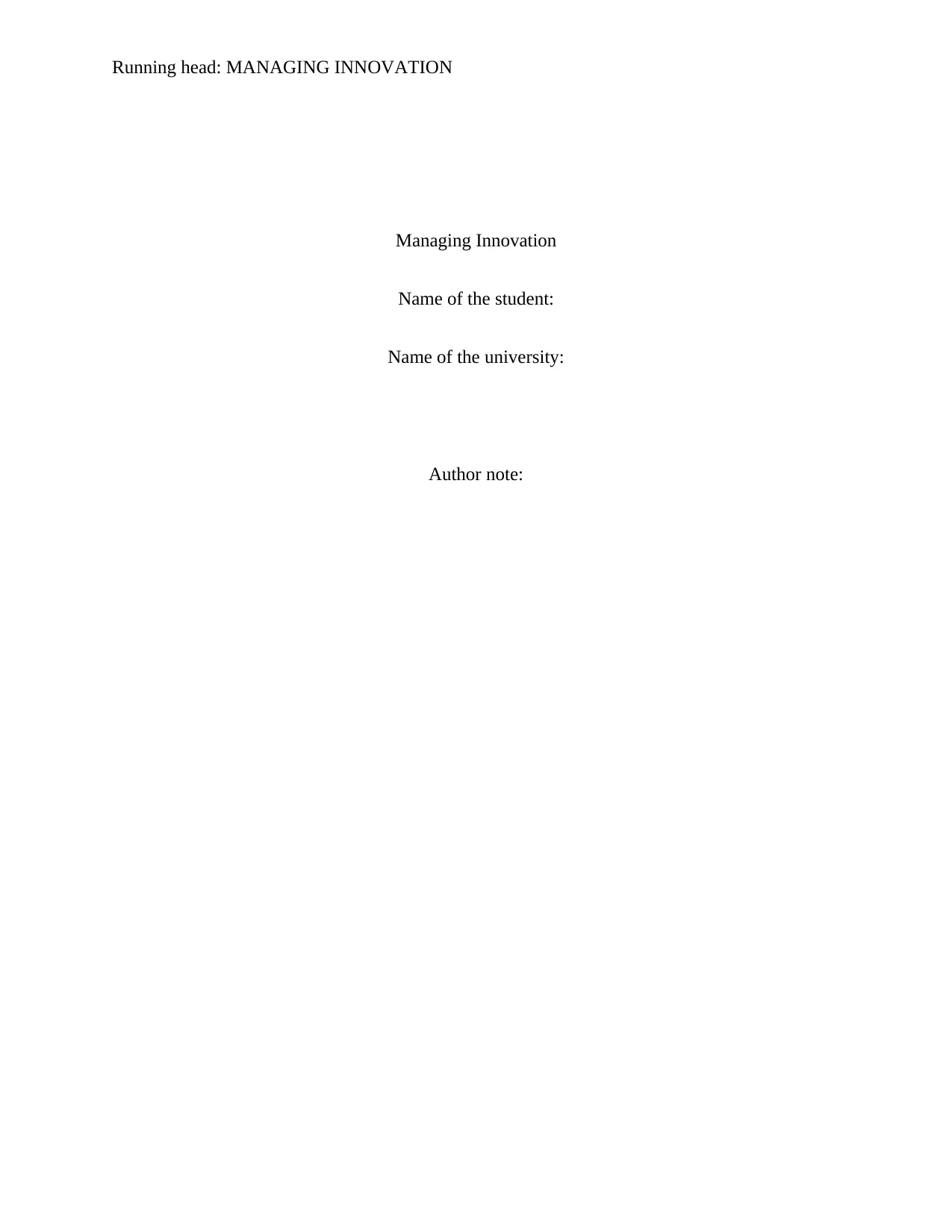
Running head: MANAGING INNOVATION
Managing Innovation
Name of the student:
Name of the university:
Author note:
Managing Innovation
Name of the student:
Name of the university:
Author note:
Secure Best Marks with AI Grader
Need help grading? Try our AI Grader for instant feedback on your assignments.
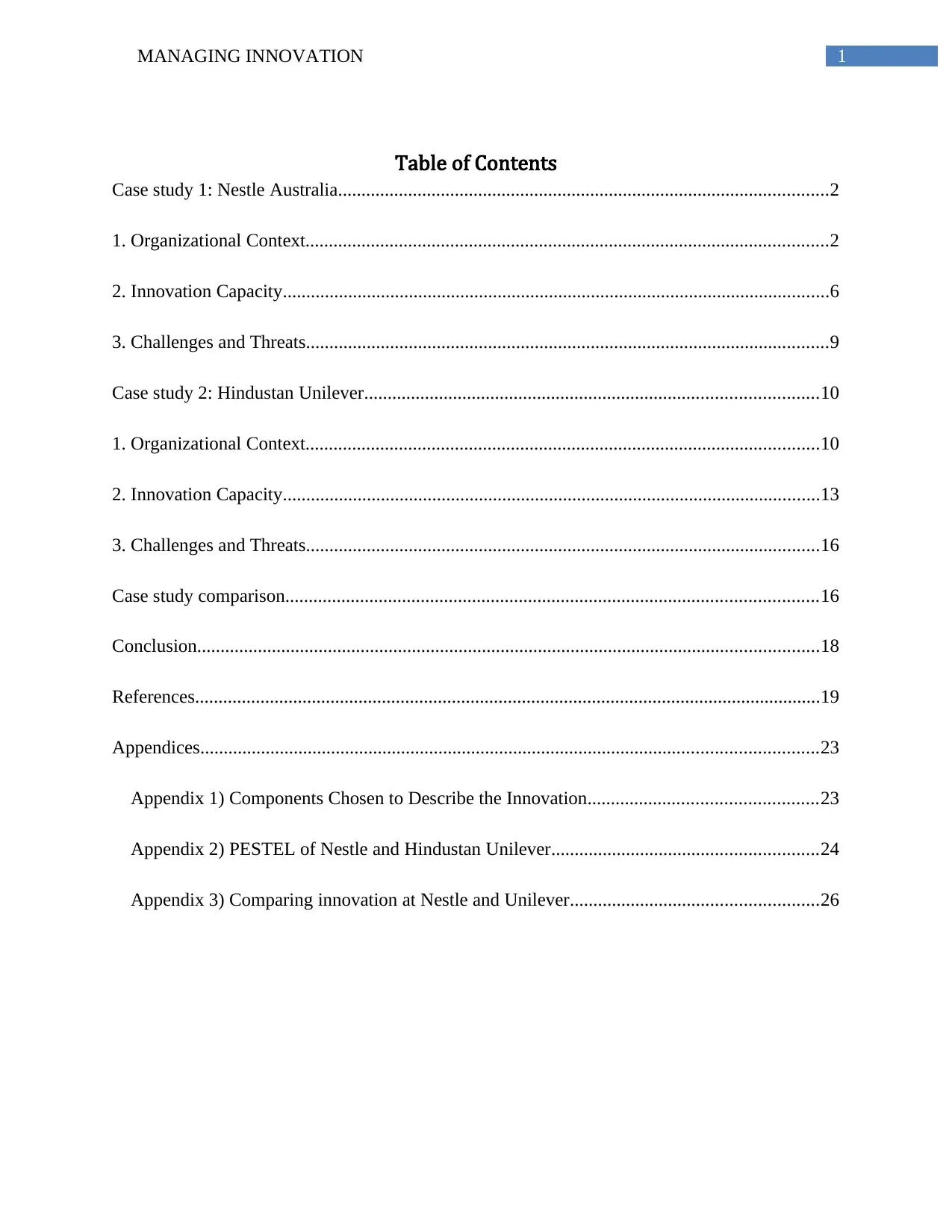
1MANAGING INNOVATION
Table of Contents
Case study 1: Nestle Australia.........................................................................................................2
1. Organizational Context................................................................................................................2
2. Innovation Capacity.....................................................................................................................6
3. Challenges and Threats................................................................................................................9
Case study 2: Hindustan Unilever.................................................................................................10
1. Organizational Context..............................................................................................................10
2. Innovation Capacity...................................................................................................................13
3. Challenges and Threats..............................................................................................................16
Case study comparison..................................................................................................................16
Conclusion.....................................................................................................................................18
References......................................................................................................................................19
Appendices....................................................................................................................................23
Appendix 1) Components Chosen to Describe the Innovation.................................................23
Appendix 2) PESTEL of Nestle and Hindustan Unilever.........................................................24
Appendix 3) Comparing innovation at Nestle and Unilever.....................................................26
Table of Contents
Case study 1: Nestle Australia.........................................................................................................2
1. Organizational Context................................................................................................................2
2. Innovation Capacity.....................................................................................................................6
3. Challenges and Threats................................................................................................................9
Case study 2: Hindustan Unilever.................................................................................................10
1. Organizational Context..............................................................................................................10
2. Innovation Capacity...................................................................................................................13
3. Challenges and Threats..............................................................................................................16
Case study comparison..................................................................................................................16
Conclusion.....................................................................................................................................18
References......................................................................................................................................19
Appendices....................................................................................................................................23
Appendix 1) Components Chosen to Describe the Innovation.................................................23
Appendix 2) PESTEL of Nestle and Hindustan Unilever.........................................................24
Appendix 3) Comparing innovation at Nestle and Unilever.....................................................26
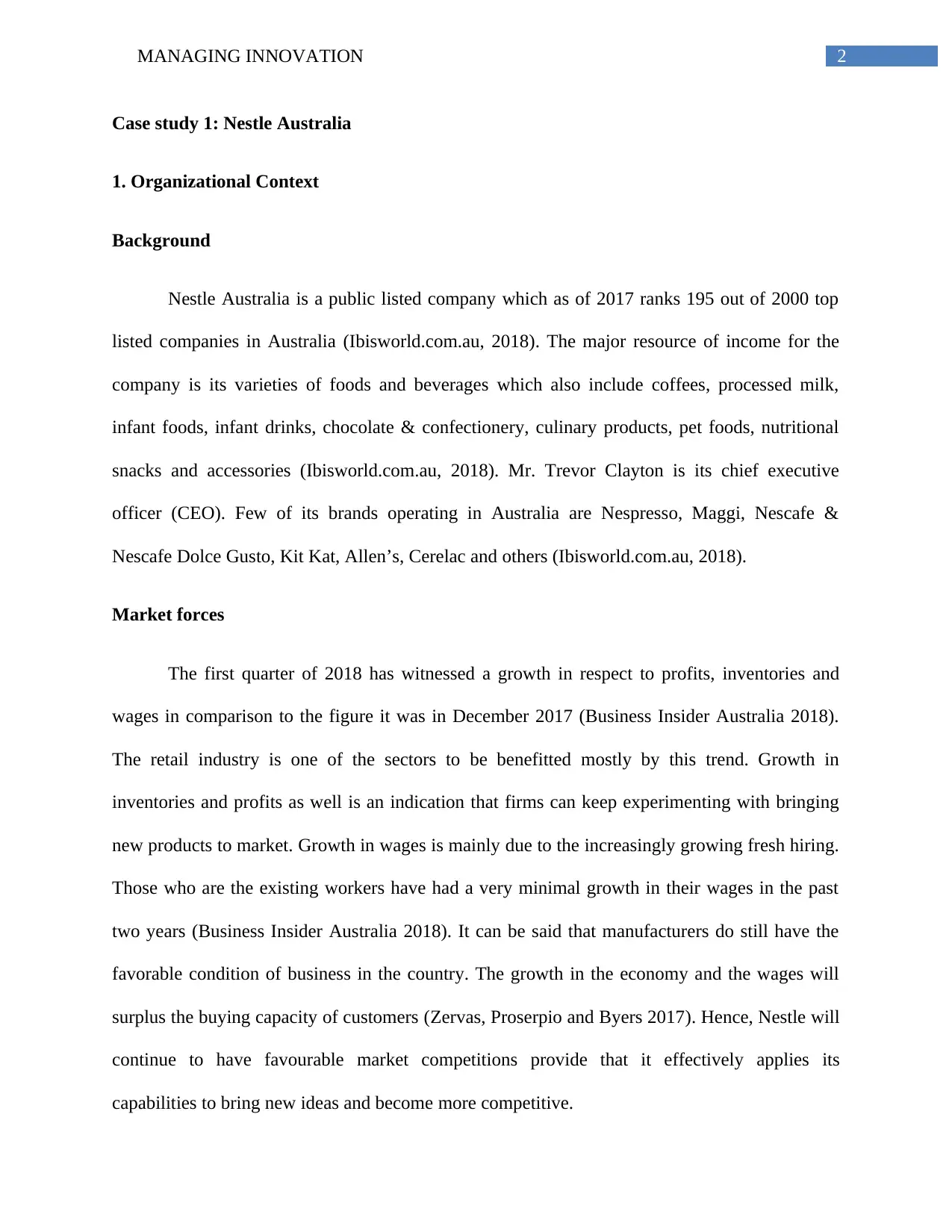
2MANAGING INNOVATION
Case study 1: Nestle Australia
1. Organizational Context
Background
Nestle Australia is a public listed company which as of 2017 ranks 195 out of 2000 top
listed companies in Australia (Ibisworld.com.au, 2018). The major resource of income for the
company is its varieties of foods and beverages which also include coffees, processed milk,
infant foods, infant drinks, chocolate & confectionery, culinary products, pet foods, nutritional
snacks and accessories (Ibisworld.com.au, 2018). Mr. Trevor Clayton is its chief executive
officer (CEO). Few of its brands operating in Australia are Nespresso, Maggi, Nescafe &
Nescafe Dolce Gusto, Kit Kat, Allen’s, Cerelac and others (Ibisworld.com.au, 2018).
Market forces
The first quarter of 2018 has witnessed a growth in respect to profits, inventories and
wages in comparison to the figure it was in December 2017 (Business Insider Australia 2018).
The retail industry is one of the sectors to be benefitted mostly by this trend. Growth in
inventories and profits as well is an indication that firms can keep experimenting with bringing
new products to market. Growth in wages is mainly due to the increasingly growing fresh hiring.
Those who are the existing workers have had a very minimal growth in their wages in the past
two years (Business Insider Australia 2018). It can be said that manufacturers do still have the
favorable condition of business in the country. The growth in the economy and the wages will
surplus the buying capacity of customers (Zervas, Proserpio and Byers 2017). Hence, Nestle will
continue to have favourable market competitions provide that it effectively applies its
capabilities to bring new ideas and become more competitive.
Case study 1: Nestle Australia
1. Organizational Context
Background
Nestle Australia is a public listed company which as of 2017 ranks 195 out of 2000 top
listed companies in Australia (Ibisworld.com.au, 2018). The major resource of income for the
company is its varieties of foods and beverages which also include coffees, processed milk,
infant foods, infant drinks, chocolate & confectionery, culinary products, pet foods, nutritional
snacks and accessories (Ibisworld.com.au, 2018). Mr. Trevor Clayton is its chief executive
officer (CEO). Few of its brands operating in Australia are Nespresso, Maggi, Nescafe &
Nescafe Dolce Gusto, Kit Kat, Allen’s, Cerelac and others (Ibisworld.com.au, 2018).
Market forces
The first quarter of 2018 has witnessed a growth in respect to profits, inventories and
wages in comparison to the figure it was in December 2017 (Business Insider Australia 2018).
The retail industry is one of the sectors to be benefitted mostly by this trend. Growth in
inventories and profits as well is an indication that firms can keep experimenting with bringing
new products to market. Growth in wages is mainly due to the increasingly growing fresh hiring.
Those who are the existing workers have had a very minimal growth in their wages in the past
two years (Business Insider Australia 2018). It can be said that manufacturers do still have the
favorable condition of business in the country. The growth in the economy and the wages will
surplus the buying capacity of customers (Zervas, Proserpio and Byers 2017). Hence, Nestle will
continue to have favourable market competitions provide that it effectively applies its
capabilities to bring new ideas and become more competitive.
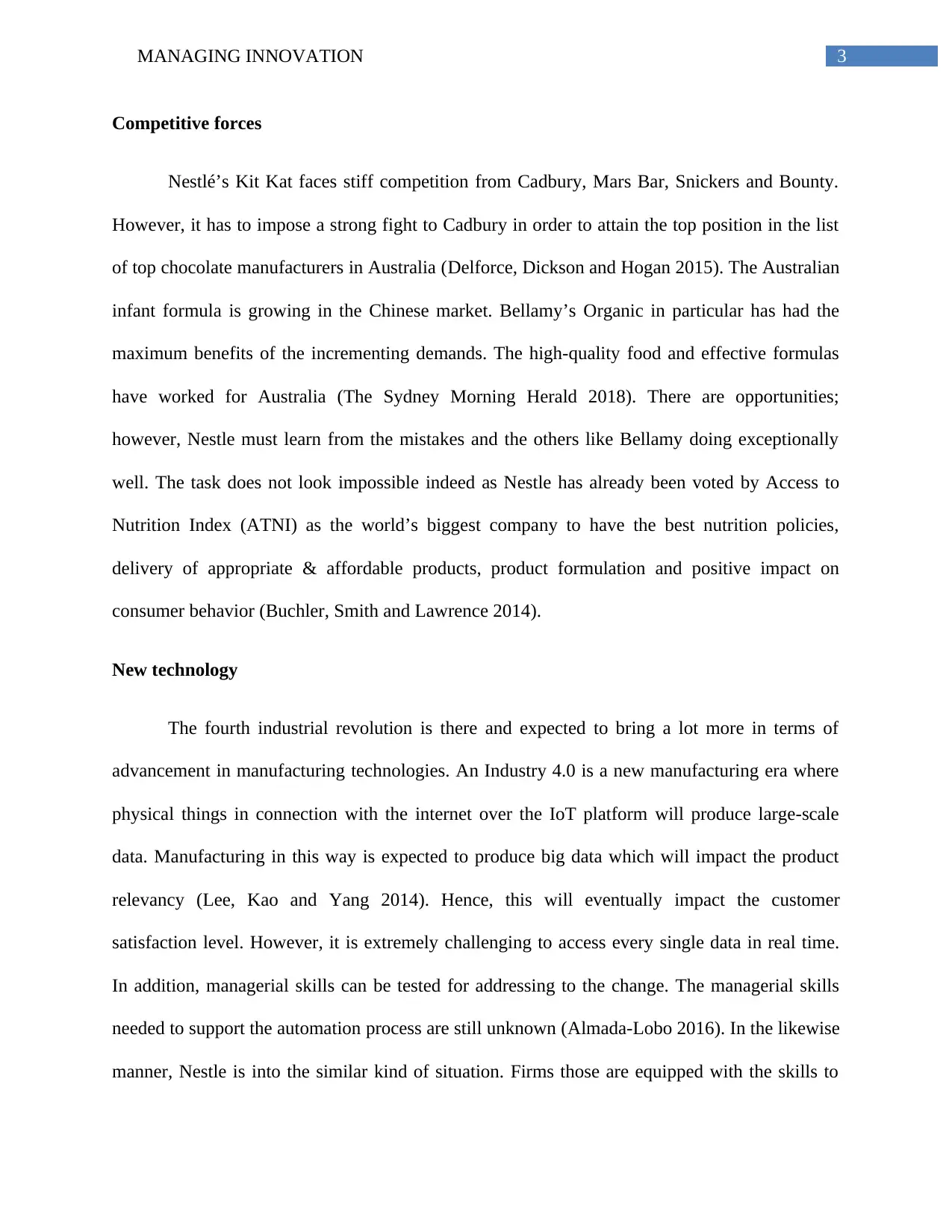
3MANAGING INNOVATION
Competitive forces
Nestlé’s Kit Kat faces stiff competition from Cadbury, Mars Bar, Snickers and Bounty.
However, it has to impose a strong fight to Cadbury in order to attain the top position in the list
of top chocolate manufacturers in Australia (Delforce, Dickson and Hogan 2015). The Australian
infant formula is growing in the Chinese market. Bellamy’s Organic in particular has had the
maximum benefits of the incrementing demands. The high-quality food and effective formulas
have worked for Australia (The Sydney Morning Herald 2018). There are opportunities;
however, Nestle must learn from the mistakes and the others like Bellamy doing exceptionally
well. The task does not look impossible indeed as Nestle has already been voted by Access to
Nutrition Index (ATNI) as the world’s biggest company to have the best nutrition policies,
delivery of appropriate & affordable products, product formulation and positive impact on
consumer behavior (Buchler, Smith and Lawrence 2014).
New technology
The fourth industrial revolution is there and expected to bring a lot more in terms of
advancement in manufacturing technologies. An Industry 4.0 is a new manufacturing era where
physical things in connection with the internet over the IoT platform will produce large-scale
data. Manufacturing in this way is expected to produce big data which will impact the product
relevancy (Lee, Kao and Yang 2014). Hence, this will eventually impact the customer
satisfaction level. However, it is extremely challenging to access every single data in real time.
In addition, managerial skills can be tested for addressing to the change. The managerial skills
needed to support the automation process are still unknown (Almada-Lobo 2016). In the likewise
manner, Nestle is into the similar kind of situation. Firms those are equipped with the skills to
Competitive forces
Nestlé’s Kit Kat faces stiff competition from Cadbury, Mars Bar, Snickers and Bounty.
However, it has to impose a strong fight to Cadbury in order to attain the top position in the list
of top chocolate manufacturers in Australia (Delforce, Dickson and Hogan 2015). The Australian
infant formula is growing in the Chinese market. Bellamy’s Organic in particular has had the
maximum benefits of the incrementing demands. The high-quality food and effective formulas
have worked for Australia (The Sydney Morning Herald 2018). There are opportunities;
however, Nestle must learn from the mistakes and the others like Bellamy doing exceptionally
well. The task does not look impossible indeed as Nestle has already been voted by Access to
Nutrition Index (ATNI) as the world’s biggest company to have the best nutrition policies,
delivery of appropriate & affordable products, product formulation and positive impact on
consumer behavior (Buchler, Smith and Lawrence 2014).
New technology
The fourth industrial revolution is there and expected to bring a lot more in terms of
advancement in manufacturing technologies. An Industry 4.0 is a new manufacturing era where
physical things in connection with the internet over the IoT platform will produce large-scale
data. Manufacturing in this way is expected to produce big data which will impact the product
relevancy (Lee, Kao and Yang 2014). Hence, this will eventually impact the customer
satisfaction level. However, it is extremely challenging to access every single data in real time.
In addition, managerial skills can be tested for addressing to the change. The managerial skills
needed to support the automation process are still unknown (Almada-Lobo 2016). In the likewise
manner, Nestle is into the similar kind of situation. Firms those are equipped with the skills to
Secure Best Marks with AI Grader
Need help grading? Try our AI Grader for instant feedback on your assignments.
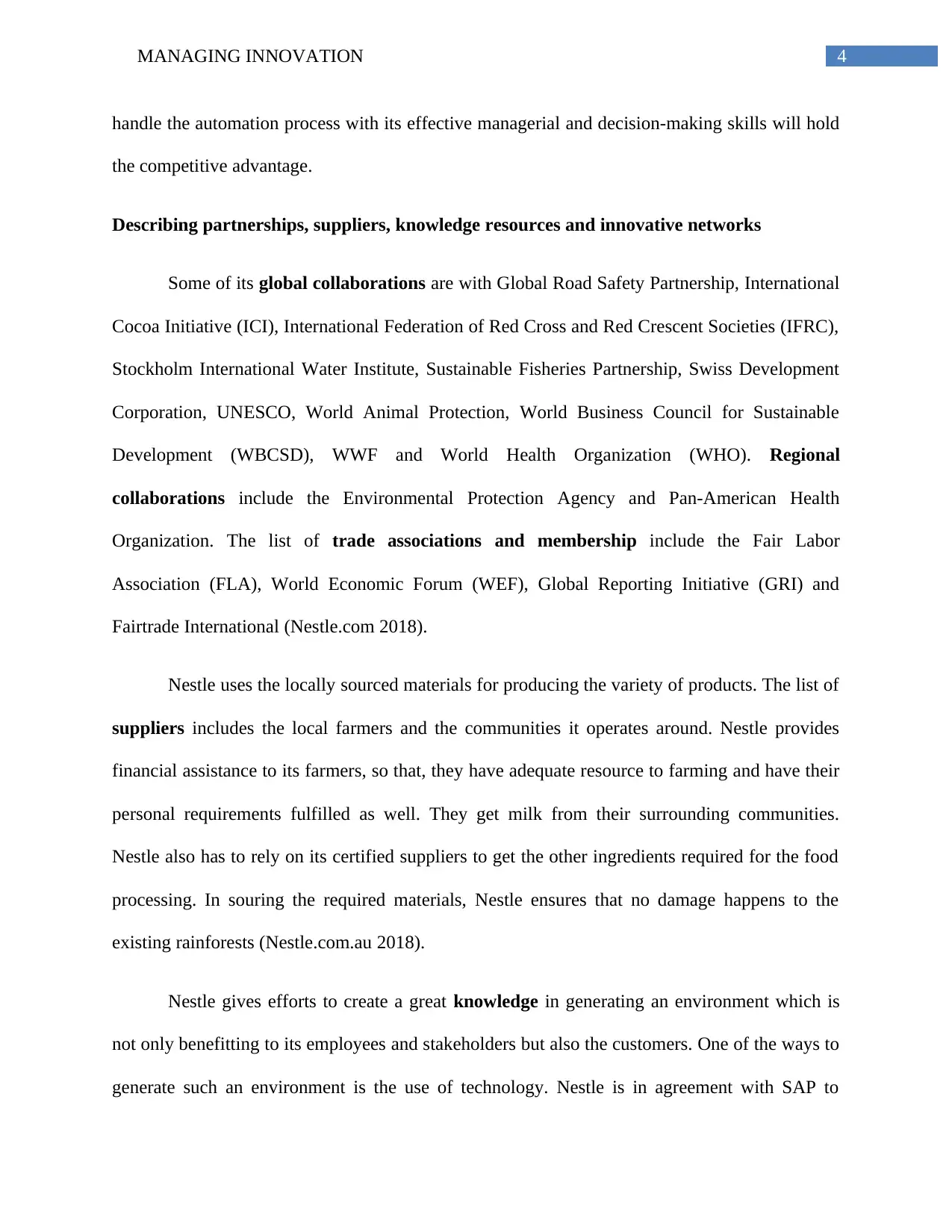
4MANAGING INNOVATION
handle the automation process with its effective managerial and decision-making skills will hold
the competitive advantage.
Describing partnerships, suppliers, knowledge resources and innovative networks
Some of its global collaborations are with Global Road Safety Partnership, International
Cocoa Initiative (ICI), International Federation of Red Cross and Red Crescent Societies (IFRC),
Stockholm International Water Institute, Sustainable Fisheries Partnership, Swiss Development
Corporation, UNESCO, World Animal Protection, World Business Council for Sustainable
Development (WBCSD), WWF and World Health Organization (WHO). Regional
collaborations include the Environmental Protection Agency and Pan-American Health
Organization. The list of trade associations and membership include the Fair Labor
Association (FLA), World Economic Forum (WEF), Global Reporting Initiative (GRI) and
Fairtrade International (Nestle.com 2018).
Nestle uses the locally sourced materials for producing the variety of products. The list of
suppliers includes the local farmers and the communities it operates around. Nestle provides
financial assistance to its farmers, so that, they have adequate resource to farming and have their
personal requirements fulfilled as well. They get milk from their surrounding communities.
Nestle also has to rely on its certified suppliers to get the other ingredients required for the food
processing. In souring the required materials, Nestle ensures that no damage happens to the
existing rainforests (Nestle.com.au 2018).
Nestle gives efforts to create a great knowledge in generating an environment which is
not only benefitting to its employees and stakeholders but also the customers. One of the ways to
generate such an environment is the use of technology. Nestle is in agreement with SAP to
handle the automation process with its effective managerial and decision-making skills will hold
the competitive advantage.
Describing partnerships, suppliers, knowledge resources and innovative networks
Some of its global collaborations are with Global Road Safety Partnership, International
Cocoa Initiative (ICI), International Federation of Red Cross and Red Crescent Societies (IFRC),
Stockholm International Water Institute, Sustainable Fisheries Partnership, Swiss Development
Corporation, UNESCO, World Animal Protection, World Business Council for Sustainable
Development (WBCSD), WWF and World Health Organization (WHO). Regional
collaborations include the Environmental Protection Agency and Pan-American Health
Organization. The list of trade associations and membership include the Fair Labor
Association (FLA), World Economic Forum (WEF), Global Reporting Initiative (GRI) and
Fairtrade International (Nestle.com 2018).
Nestle uses the locally sourced materials for producing the variety of products. The list of
suppliers includes the local farmers and the communities it operates around. Nestle provides
financial assistance to its farmers, so that, they have adequate resource to farming and have their
personal requirements fulfilled as well. They get milk from their surrounding communities.
Nestle also has to rely on its certified suppliers to get the other ingredients required for the food
processing. In souring the required materials, Nestle ensures that no damage happens to the
existing rainforests (Nestle.com.au 2018).
Nestle gives efforts to create a great knowledge in generating an environment which is
not only benefitting to its employees and stakeholders but also the customers. One of the ways to
generate such an environment is the use of technology. Nestle is in agreement with SAP to
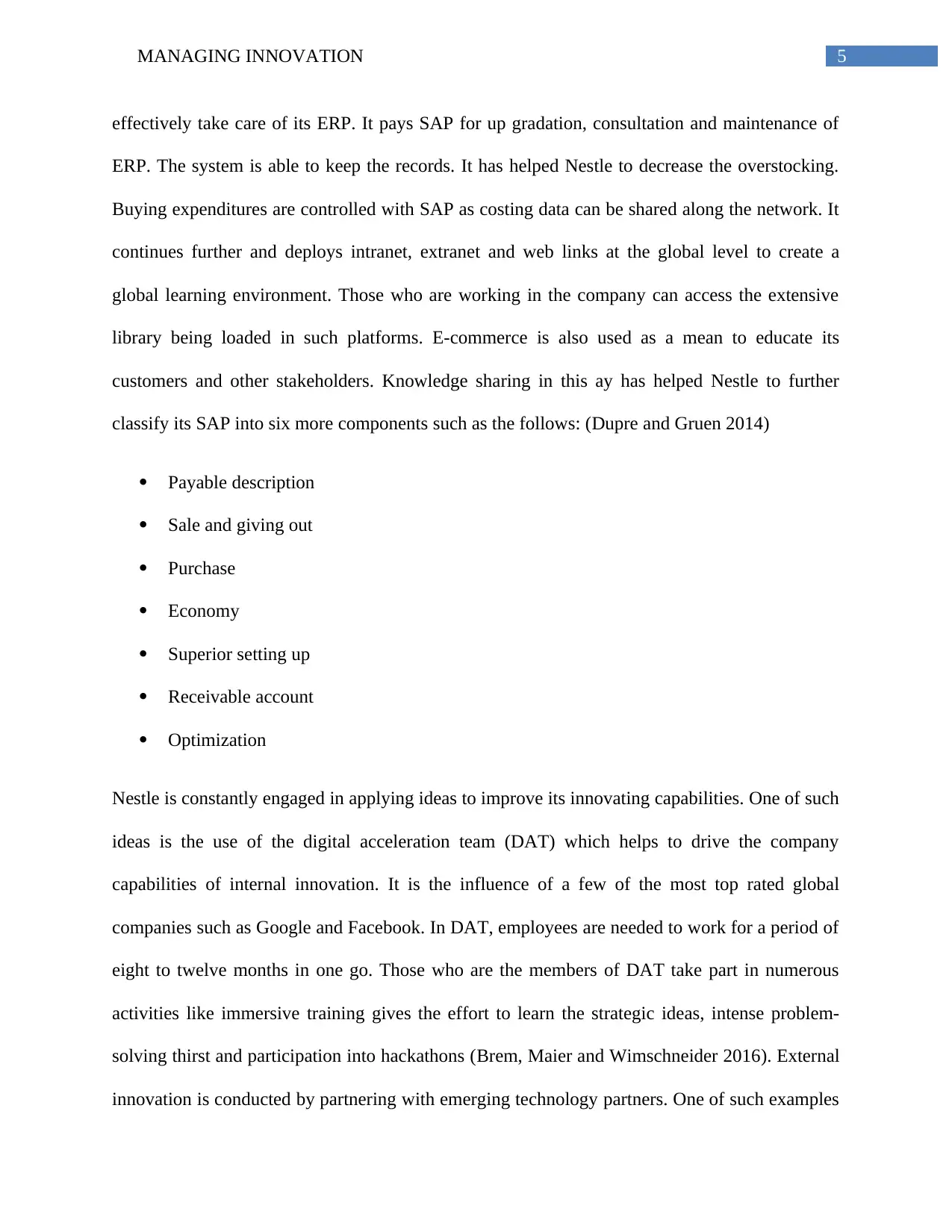
5MANAGING INNOVATION
effectively take care of its ERP. It pays SAP for up gradation, consultation and maintenance of
ERP. The system is able to keep the records. It has helped Nestle to decrease the overstocking.
Buying expenditures are controlled with SAP as costing data can be shared along the network. It
continues further and deploys intranet, extranet and web links at the global level to create a
global learning environment. Those who are working in the company can access the extensive
library being loaded in such platforms. E-commerce is also used as a mean to educate its
customers and other stakeholders. Knowledge sharing in this ay has helped Nestle to further
classify its SAP into six more components such as the follows: (Dupre and Gruen 2014)
Payable description
Sale and giving out
Purchase
Economy
Superior setting up
Receivable account
Optimization
Nestle is constantly engaged in applying ideas to improve its innovating capabilities. One of such
ideas is the use of the digital acceleration team (DAT) which helps to drive the company
capabilities of internal innovation. It is the influence of a few of the most top rated global
companies such as Google and Facebook. In DAT, employees are needed to work for a period of
eight to twelve months in one go. Those who are the members of DAT take part in numerous
activities like immersive training gives the effort to learn the strategic ideas, intense problem-
solving thirst and participation into hackathons (Brem, Maier and Wimschneider 2016). External
innovation is conducted by partnering with emerging technology partners. One of such examples
effectively take care of its ERP. It pays SAP for up gradation, consultation and maintenance of
ERP. The system is able to keep the records. It has helped Nestle to decrease the overstocking.
Buying expenditures are controlled with SAP as costing data can be shared along the network. It
continues further and deploys intranet, extranet and web links at the global level to create a
global learning environment. Those who are working in the company can access the extensive
library being loaded in such platforms. E-commerce is also used as a mean to educate its
customers and other stakeholders. Knowledge sharing in this ay has helped Nestle to further
classify its SAP into six more components such as the follows: (Dupre and Gruen 2014)
Payable description
Sale and giving out
Purchase
Economy
Superior setting up
Receivable account
Optimization
Nestle is constantly engaged in applying ideas to improve its innovating capabilities. One of such
ideas is the use of the digital acceleration team (DAT) which helps to drive the company
capabilities of internal innovation. It is the influence of a few of the most top rated global
companies such as Google and Facebook. In DAT, employees are needed to work for a period of
eight to twelve months in one go. Those who are the members of DAT take part in numerous
activities like immersive training gives the effort to learn the strategic ideas, intense problem-
solving thirst and participation into hackathons (Brem, Maier and Wimschneider 2016). External
innovation is conducted by partnering with emerging technology partners. One of such examples
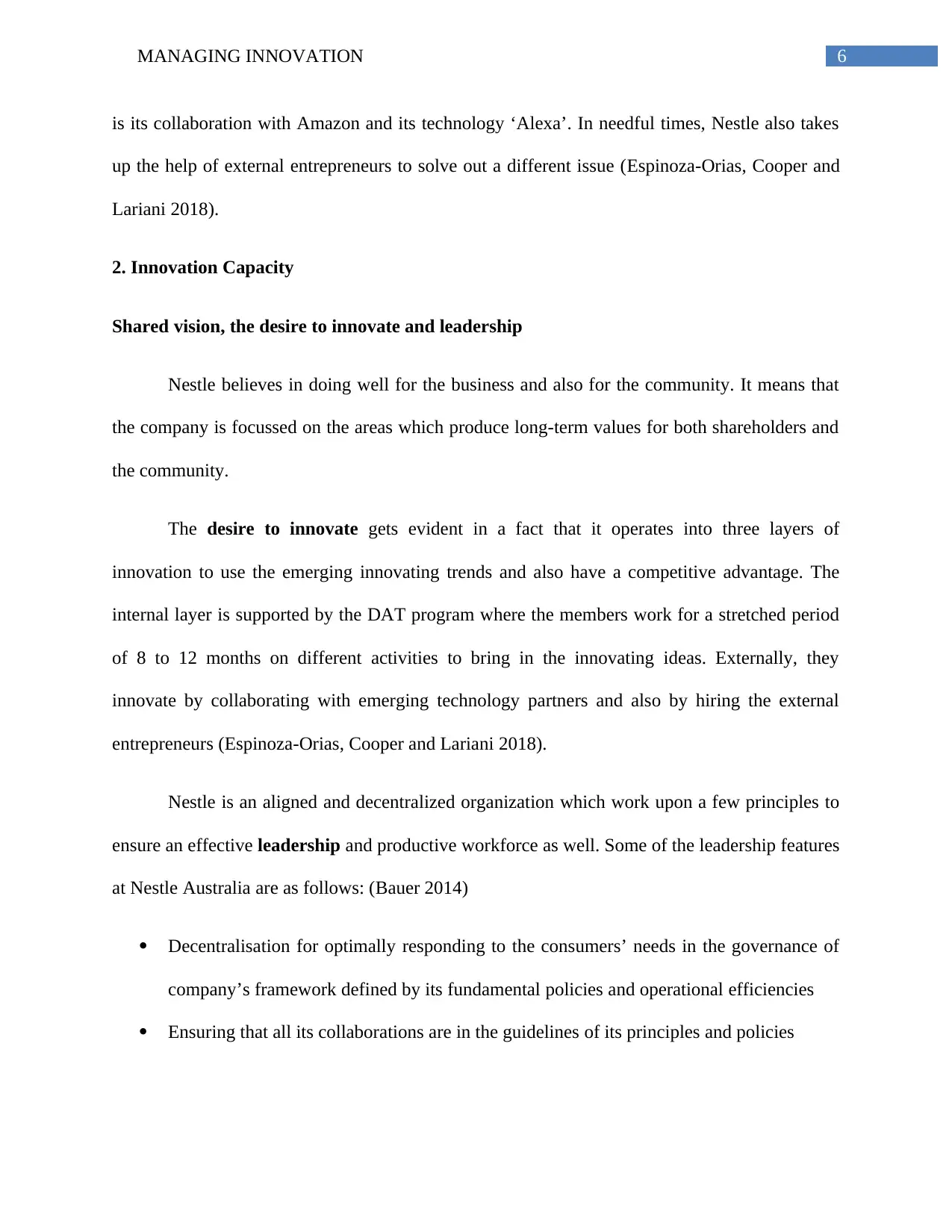
6MANAGING INNOVATION
is its collaboration with Amazon and its technology ‘Alexa’. In needful times, Nestle also takes
up the help of external entrepreneurs to solve out a different issue (Espinoza-Orias, Cooper and
Lariani 2018).
2. Innovation Capacity
Shared vision, the desire to innovate and leadership
Nestle believes in doing well for the business and also for the community. It means that
the company is focussed on the areas which produce long-term values for both shareholders and
the community.
The desire to innovate gets evident in a fact that it operates into three layers of
innovation to use the emerging innovating trends and also have a competitive advantage. The
internal layer is supported by the DAT program where the members work for a stretched period
of 8 to 12 months on different activities to bring in the innovating ideas. Externally, they
innovate by collaborating with emerging technology partners and also by hiring the external
entrepreneurs (Espinoza-Orias, Cooper and Lariani 2018).
Nestle is an aligned and decentralized organization which work upon a few principles to
ensure an effective leadership and productive workforce as well. Some of the leadership features
at Nestle Australia are as follows: (Bauer 2014)
Decentralisation for optimally responding to the consumers’ needs in the governance of
company’s framework defined by its fundamental policies and operational efficiencies
Ensuring that all its collaborations are in the guidelines of its principles and policies
is its collaboration with Amazon and its technology ‘Alexa’. In needful times, Nestle also takes
up the help of external entrepreneurs to solve out a different issue (Espinoza-Orias, Cooper and
Lariani 2018).
2. Innovation Capacity
Shared vision, the desire to innovate and leadership
Nestle believes in doing well for the business and also for the community. It means that
the company is focussed on the areas which produce long-term values for both shareholders and
the community.
The desire to innovate gets evident in a fact that it operates into three layers of
innovation to use the emerging innovating trends and also have a competitive advantage. The
internal layer is supported by the DAT program where the members work for a stretched period
of 8 to 12 months on different activities to bring in the innovating ideas. Externally, they
innovate by collaborating with emerging technology partners and also by hiring the external
entrepreneurs (Espinoza-Orias, Cooper and Lariani 2018).
Nestle is an aligned and decentralized organization which work upon a few principles to
ensure an effective leadership and productive workforce as well. Some of the leadership features
at Nestle Australia are as follows: (Bauer 2014)
Decentralisation for optimally responding to the consumers’ needs in the governance of
company’s framework defined by its fundamental policies and operational efficiencies
Ensuring that all its collaborations are in the guidelines of its principles and policies
Paraphrase This Document
Need a fresh take? Get an instant paraphrase of this document with our AI Paraphraser
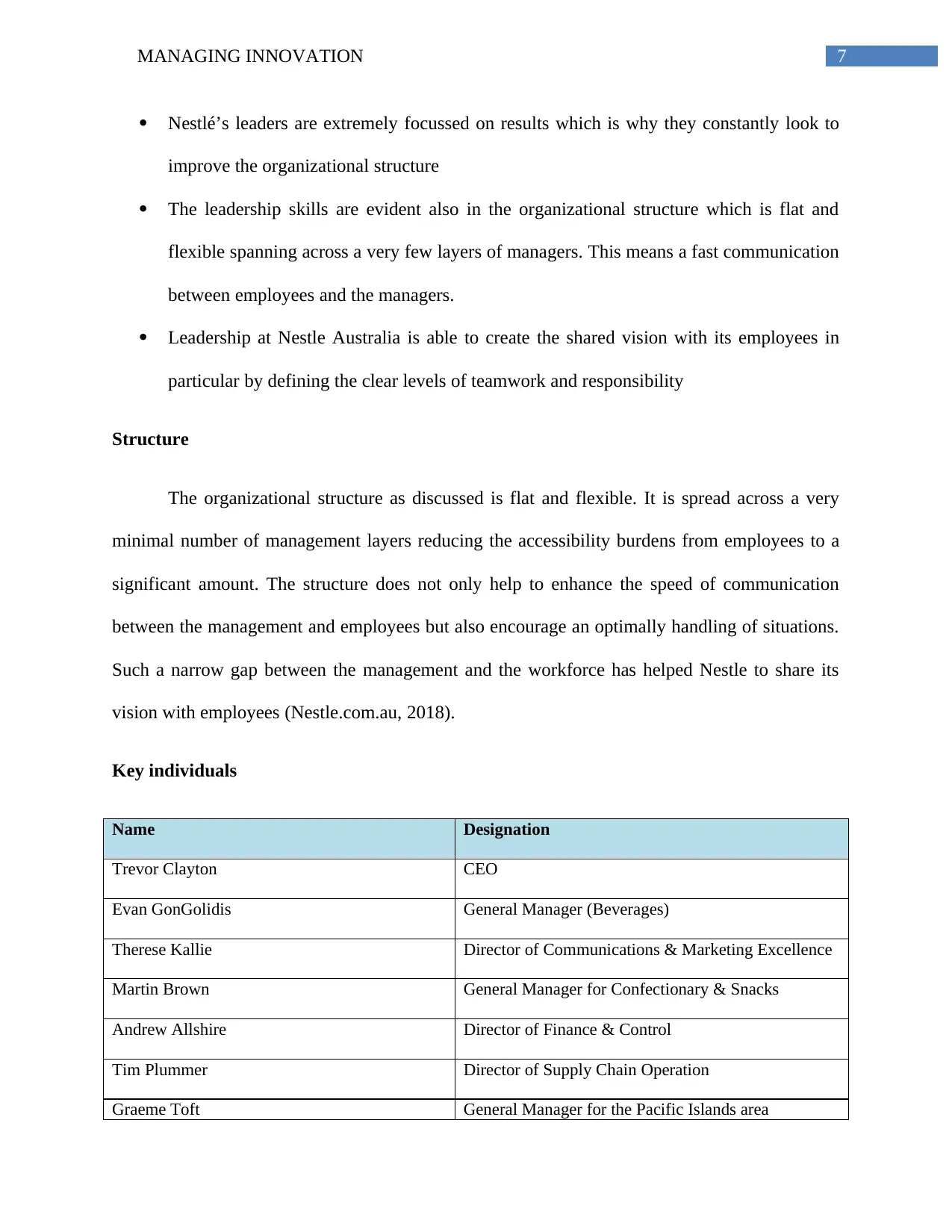
7MANAGING INNOVATION
Nestlé’s leaders are extremely focussed on results which is why they constantly look to
improve the organizational structure
The leadership skills are evident also in the organizational structure which is flat and
flexible spanning across a very few layers of managers. This means a fast communication
between employees and the managers.
Leadership at Nestle Australia is able to create the shared vision with its employees in
particular by defining the clear levels of teamwork and responsibility
Structure
The organizational structure as discussed is flat and flexible. It is spread across a very
minimal number of management layers reducing the accessibility burdens from employees to a
significant amount. The structure does not only help to enhance the speed of communication
between the management and employees but also encourage an optimally handling of situations.
Such a narrow gap between the management and the workforce has helped Nestle to share its
vision with employees (Nestle.com.au, 2018).
Key individuals
Name Designation
Trevor Clayton CEO
Evan GonGolidis General Manager (Beverages)
Therese Kallie Director of Communications & Marketing Excellence
Martin Brown General Manager for Confectionary & Snacks
Andrew Allshire Director of Finance & Control
Tim Plummer Director of Supply Chain Operation
Graeme Toft General Manager for the Pacific Islands area
Nestlé’s leaders are extremely focussed on results which is why they constantly look to
improve the organizational structure
The leadership skills are evident also in the organizational structure which is flat and
flexible spanning across a very few layers of managers. This means a fast communication
between employees and the managers.
Leadership at Nestle Australia is able to create the shared vision with its employees in
particular by defining the clear levels of teamwork and responsibility
Structure
The organizational structure as discussed is flat and flexible. It is spread across a very
minimal number of management layers reducing the accessibility burdens from employees to a
significant amount. The structure does not only help to enhance the speed of communication
between the management and employees but also encourage an optimally handling of situations.
Such a narrow gap between the management and the workforce has helped Nestle to share its
vision with employees (Nestle.com.au, 2018).
Key individuals
Name Designation
Trevor Clayton CEO
Evan GonGolidis General Manager (Beverages)
Therese Kallie Director of Communications & Marketing Excellence
Martin Brown General Manager for Confectionary & Snacks
Andrew Allshire Director of Finance & Control
Tim Plummer Director of Supply Chain Operation
Graeme Toft General Manager for the Pacific Islands area
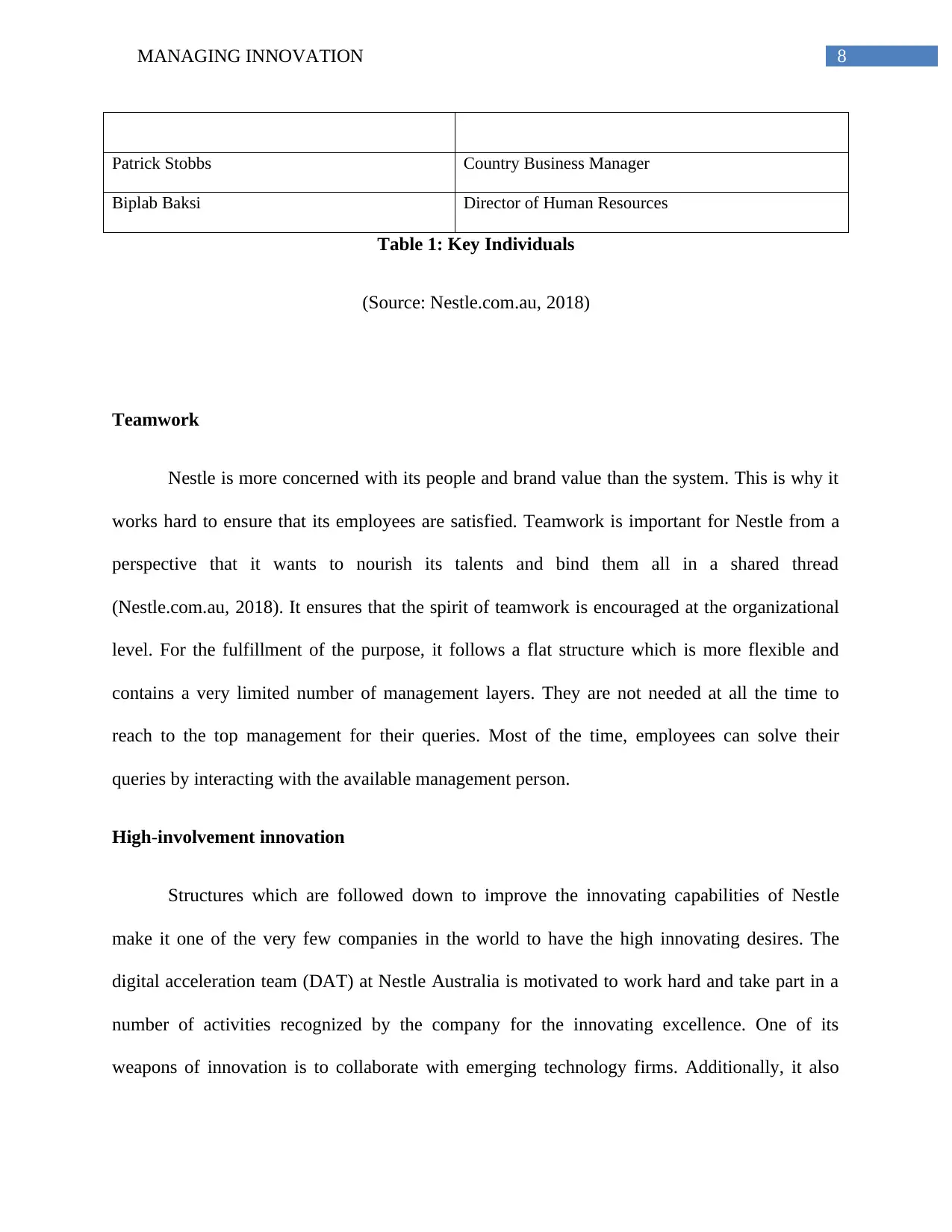
8MANAGING INNOVATION
Patrick Stobbs Country Business Manager
Biplab Baksi Director of Human Resources
Table 1: Key Individuals
(Source: Nestle.com.au, 2018)
Teamwork
Nestle is more concerned with its people and brand value than the system. This is why it
works hard to ensure that its employees are satisfied. Teamwork is important for Nestle from a
perspective that it wants to nourish its talents and bind them all in a shared thread
(Nestle.com.au, 2018). It ensures that the spirit of teamwork is encouraged at the organizational
level. For the fulfillment of the purpose, it follows a flat structure which is more flexible and
contains a very limited number of management layers. They are not needed at all the time to
reach to the top management for their queries. Most of the time, employees can solve their
queries by interacting with the available management person.
High-involvement innovation
Structures which are followed down to improve the innovating capabilities of Nestle
make it one of the very few companies in the world to have the high innovating desires. The
digital acceleration team (DAT) at Nestle Australia is motivated to work hard and take part in a
number of activities recognized by the company for the innovating excellence. One of its
weapons of innovation is to collaborate with emerging technology firms. Additionally, it also
Patrick Stobbs Country Business Manager
Biplab Baksi Director of Human Resources
Table 1: Key Individuals
(Source: Nestle.com.au, 2018)
Teamwork
Nestle is more concerned with its people and brand value than the system. This is why it
works hard to ensure that its employees are satisfied. Teamwork is important for Nestle from a
perspective that it wants to nourish its talents and bind them all in a shared thread
(Nestle.com.au, 2018). It ensures that the spirit of teamwork is encouraged at the organizational
level. For the fulfillment of the purpose, it follows a flat structure which is more flexible and
contains a very limited number of management layers. They are not needed at all the time to
reach to the top management for their queries. Most of the time, employees can solve their
queries by interacting with the available management person.
High-involvement innovation
Structures which are followed down to improve the innovating capabilities of Nestle
make it one of the very few companies in the world to have the high innovating desires. The
digital acceleration team (DAT) at Nestle Australia is motivated to work hard and take part in a
number of activities recognized by the company for the innovating excellence. One of its
weapons of innovation is to collaborate with emerging technology firms. Additionally, it also
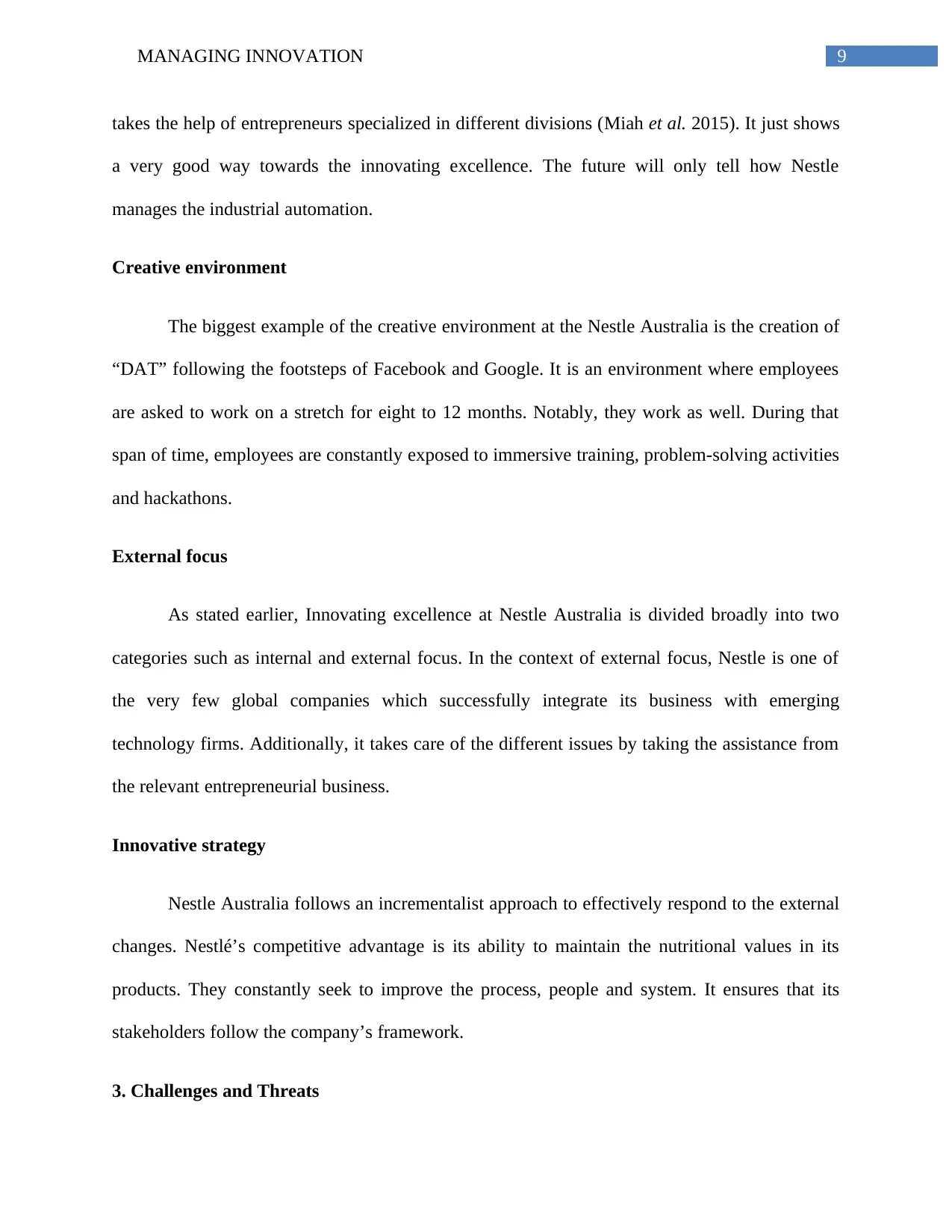
9MANAGING INNOVATION
takes the help of entrepreneurs specialized in different divisions (Miah et al. 2015). It just shows
a very good way towards the innovating excellence. The future will only tell how Nestle
manages the industrial automation.
Creative environment
The biggest example of the creative environment at the Nestle Australia is the creation of
“DAT” following the footsteps of Facebook and Google. It is an environment where employees
are asked to work on a stretch for eight to 12 months. Notably, they work as well. During that
span of time, employees are constantly exposed to immersive training, problem-solving activities
and hackathons.
External focus
As stated earlier, Innovating excellence at Nestle Australia is divided broadly into two
categories such as internal and external focus. In the context of external focus, Nestle is one of
the very few global companies which successfully integrate its business with emerging
technology firms. Additionally, it takes care of the different issues by taking the assistance from
the relevant entrepreneurial business.
Innovative strategy
Nestle Australia follows an incrementalist approach to effectively respond to the external
changes. Nestlé’s competitive advantage is its ability to maintain the nutritional values in its
products. They constantly seek to improve the process, people and system. It ensures that its
stakeholders follow the company’s framework.
3. Challenges and Threats
takes the help of entrepreneurs specialized in different divisions (Miah et al. 2015). It just shows
a very good way towards the innovating excellence. The future will only tell how Nestle
manages the industrial automation.
Creative environment
The biggest example of the creative environment at the Nestle Australia is the creation of
“DAT” following the footsteps of Facebook and Google. It is an environment where employees
are asked to work on a stretch for eight to 12 months. Notably, they work as well. During that
span of time, employees are constantly exposed to immersive training, problem-solving activities
and hackathons.
External focus
As stated earlier, Innovating excellence at Nestle Australia is divided broadly into two
categories such as internal and external focus. In the context of external focus, Nestle is one of
the very few global companies which successfully integrate its business with emerging
technology firms. Additionally, it takes care of the different issues by taking the assistance from
the relevant entrepreneurial business.
Innovative strategy
Nestle Australia follows an incrementalist approach to effectively respond to the external
changes. Nestlé’s competitive advantage is its ability to maintain the nutritional values in its
products. They constantly seek to improve the process, people and system. It ensures that its
stakeholders follow the company’s framework.
3. Challenges and Threats
Secure Best Marks with AI Grader
Need help grading? Try our AI Grader for instant feedback on your assignments.
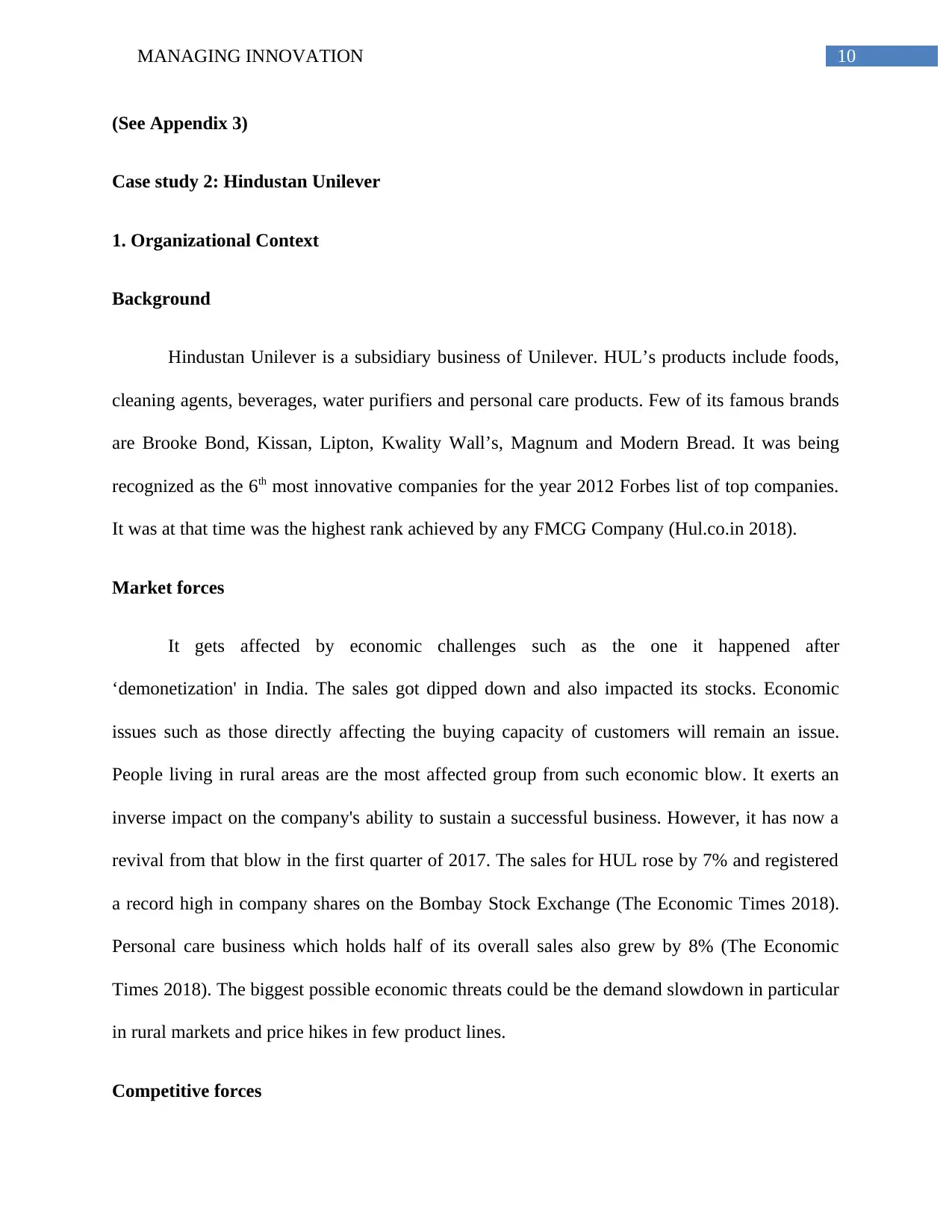
10MANAGING INNOVATION
(See Appendix 3)
Case study 2: Hindustan Unilever
1. Organizational Context
Background
Hindustan Unilever is a subsidiary business of Unilever. HUL’s products include foods,
cleaning agents, beverages, water purifiers and personal care products. Few of its famous brands
are Brooke Bond, Kissan, Lipton, Kwality Wall’s, Magnum and Modern Bread. It was being
recognized as the 6th most innovative companies for the year 2012 Forbes list of top companies.
It was at that time was the highest rank achieved by any FMCG Company (Hul.co.in 2018).
Market forces
It gets affected by economic challenges such as the one it happened after
‘demonetization' in India. The sales got dipped down and also impacted its stocks. Economic
issues such as those directly affecting the buying capacity of customers will remain an issue.
People living in rural areas are the most affected group from such economic blow. It exerts an
inverse impact on the company's ability to sustain a successful business. However, it has now a
revival from that blow in the first quarter of 2017. The sales for HUL rose by 7% and registered
a record high in company shares on the Bombay Stock Exchange (The Economic Times 2018).
Personal care business which holds half of its overall sales also grew by 8% (The Economic
Times 2018). The biggest possible economic threats could be the demand slowdown in particular
in rural markets and price hikes in few product lines.
Competitive forces
(See Appendix 3)
Case study 2: Hindustan Unilever
1. Organizational Context
Background
Hindustan Unilever is a subsidiary business of Unilever. HUL’s products include foods,
cleaning agents, beverages, water purifiers and personal care products. Few of its famous brands
are Brooke Bond, Kissan, Lipton, Kwality Wall’s, Magnum and Modern Bread. It was being
recognized as the 6th most innovative companies for the year 2012 Forbes list of top companies.
It was at that time was the highest rank achieved by any FMCG Company (Hul.co.in 2018).
Market forces
It gets affected by economic challenges such as the one it happened after
‘demonetization' in India. The sales got dipped down and also impacted its stocks. Economic
issues such as those directly affecting the buying capacity of customers will remain an issue.
People living in rural areas are the most affected group from such economic blow. It exerts an
inverse impact on the company's ability to sustain a successful business. However, it has now a
revival from that blow in the first quarter of 2017. The sales for HUL rose by 7% and registered
a record high in company shares on the Bombay Stock Exchange (The Economic Times 2018).
Personal care business which holds half of its overall sales also grew by 8% (The Economic
Times 2018). The biggest possible economic threats could be the demand slowdown in particular
in rural markets and price hikes in few product lines.
Competitive forces
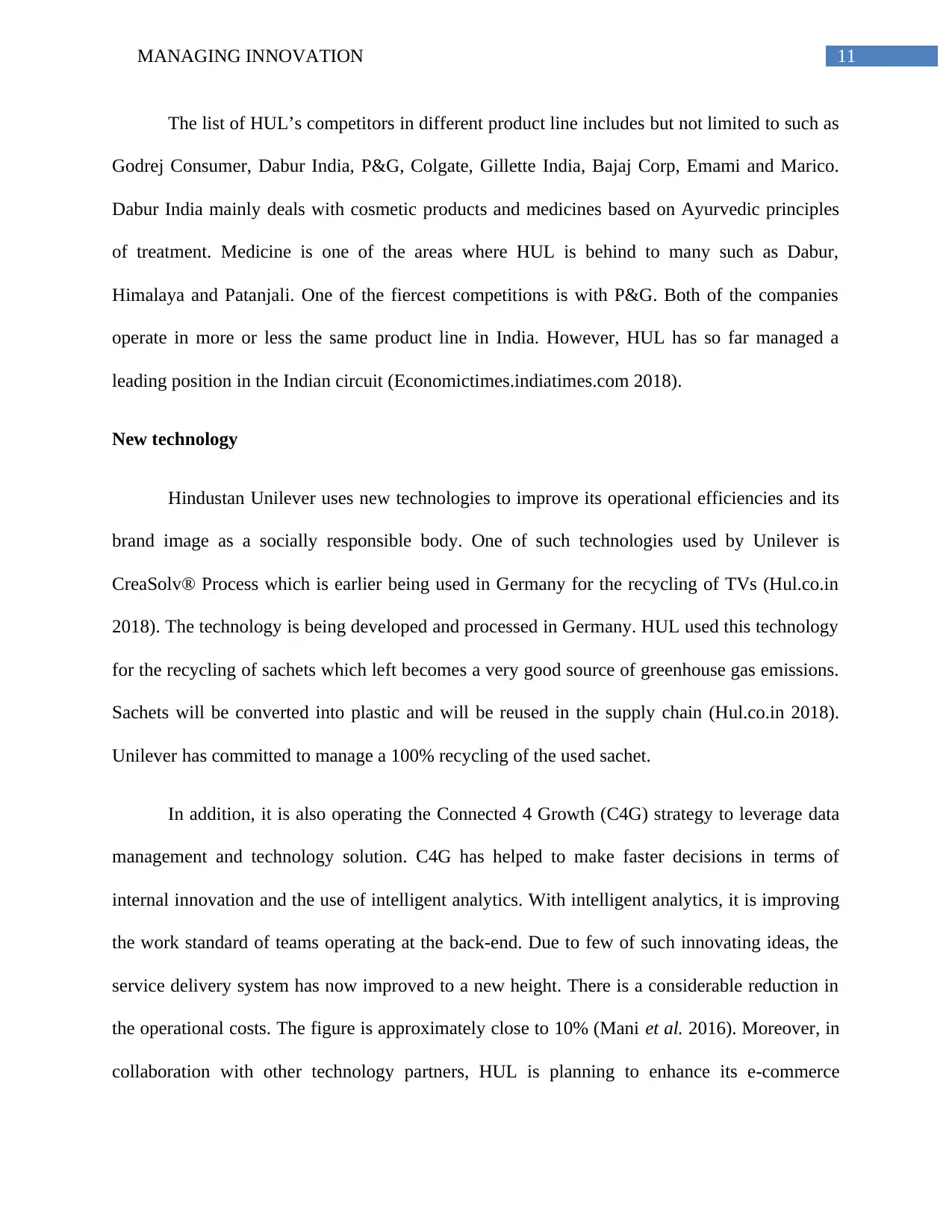
11MANAGING INNOVATION
The list of HUL’s competitors in different product line includes but not limited to such as
Godrej Consumer, Dabur India, P&G, Colgate, Gillette India, Bajaj Corp, Emami and Marico.
Dabur India mainly deals with cosmetic products and medicines based on Ayurvedic principles
of treatment. Medicine is one of the areas where HUL is behind to many such as Dabur,
Himalaya and Patanjali. One of the fiercest competitions is with P&G. Both of the companies
operate in more or less the same product line in India. However, HUL has so far managed a
leading position in the Indian circuit (Economictimes.indiatimes.com 2018).
New technology
Hindustan Unilever uses new technologies to improve its operational efficiencies and its
brand image as a socially responsible body. One of such technologies used by Unilever is
CreaSolv® Process which is earlier being used in Germany for the recycling of TVs (Hul.co.in
2018). The technology is being developed and processed in Germany. HUL used this technology
for the recycling of sachets which left becomes a very good source of greenhouse gas emissions.
Sachets will be converted into plastic and will be reused in the supply chain (Hul.co.in 2018).
Unilever has committed to manage a 100% recycling of the used sachet.
In addition, it is also operating the Connected 4 Growth (C4G) strategy to leverage data
management and technology solution. C4G has helped to make faster decisions in terms of
internal innovation and the use of intelligent analytics. With intelligent analytics, it is improving
the work standard of teams operating at the back-end. Due to few of such innovating ideas, the
service delivery system has now improved to a new height. There is a considerable reduction in
the operational costs. The figure is approximately close to 10% (Mani et al. 2016). Moreover, in
collaboration with other technology partners, HUL is planning to enhance its e-commerce
The list of HUL’s competitors in different product line includes but not limited to such as
Godrej Consumer, Dabur India, P&G, Colgate, Gillette India, Bajaj Corp, Emami and Marico.
Dabur India mainly deals with cosmetic products and medicines based on Ayurvedic principles
of treatment. Medicine is one of the areas where HUL is behind to many such as Dabur,
Himalaya and Patanjali. One of the fiercest competitions is with P&G. Both of the companies
operate in more or less the same product line in India. However, HUL has so far managed a
leading position in the Indian circuit (Economictimes.indiatimes.com 2018).
New technology
Hindustan Unilever uses new technologies to improve its operational efficiencies and its
brand image as a socially responsible body. One of such technologies used by Unilever is
CreaSolv® Process which is earlier being used in Germany for the recycling of TVs (Hul.co.in
2018). The technology is being developed and processed in Germany. HUL used this technology
for the recycling of sachets which left becomes a very good source of greenhouse gas emissions.
Sachets will be converted into plastic and will be reused in the supply chain (Hul.co.in 2018).
Unilever has committed to manage a 100% recycling of the used sachet.
In addition, it is also operating the Connected 4 Growth (C4G) strategy to leverage data
management and technology solution. C4G has helped to make faster decisions in terms of
internal innovation and the use of intelligent analytics. With intelligent analytics, it is improving
the work standard of teams operating at the back-end. Due to few of such innovating ideas, the
service delivery system has now improved to a new height. There is a considerable reduction in
the operational costs. The figure is approximately close to 10% (Mani et al. 2016). Moreover, in
collaboration with other technology partners, HUL is planning to enhance its e-commerce
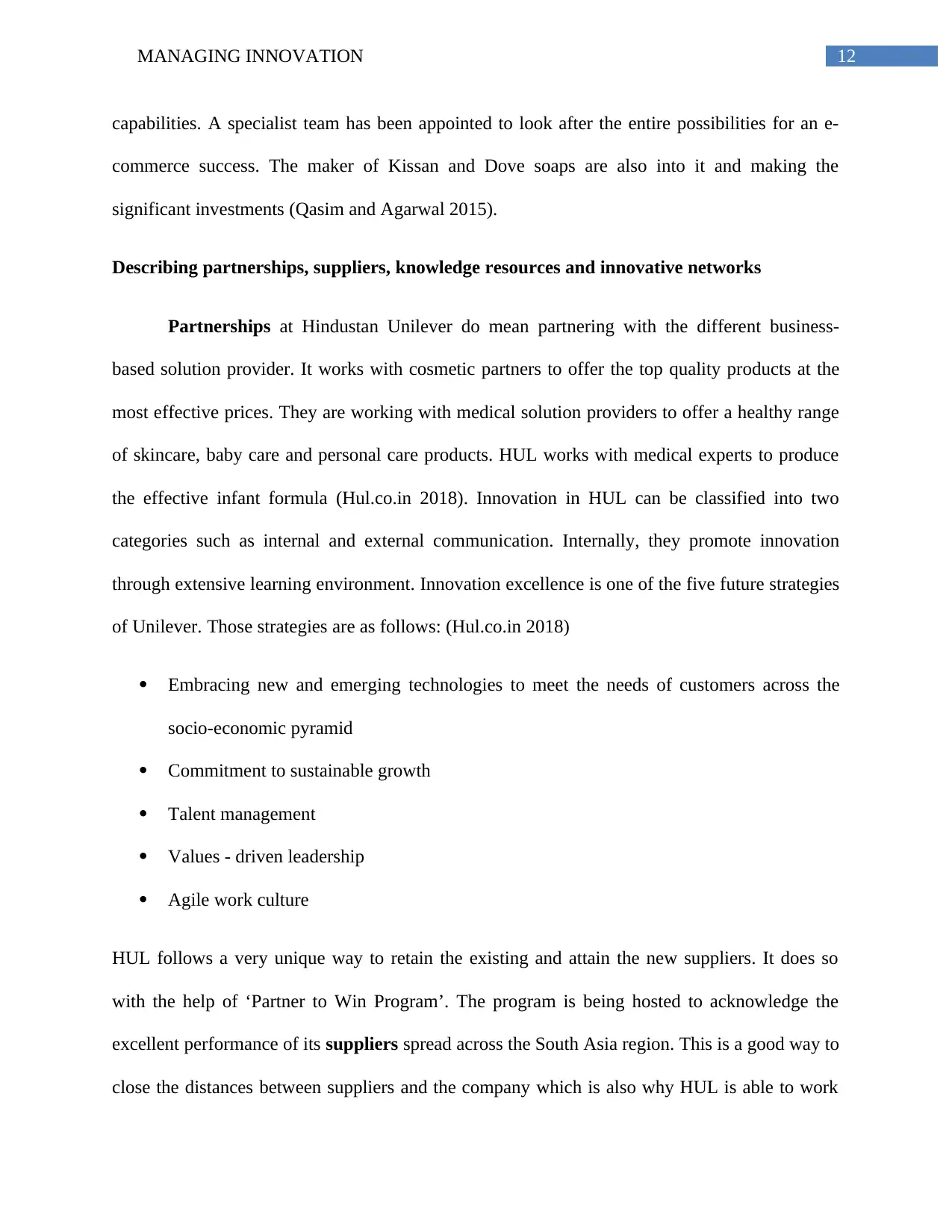
12MANAGING INNOVATION
capabilities. A specialist team has been appointed to look after the entire possibilities for an e-
commerce success. The maker of Kissan and Dove soaps are also into it and making the
significant investments (Qasim and Agarwal 2015).
Describing partnerships, suppliers, knowledge resources and innovative networks
Partnerships at Hindustan Unilever do mean partnering with the different business-
based solution provider. It works with cosmetic partners to offer the top quality products at the
most effective prices. They are working with medical solution providers to offer a healthy range
of skincare, baby care and personal care products. HUL works with medical experts to produce
the effective infant formula (Hul.co.in 2018). Innovation in HUL can be classified into two
categories such as internal and external communication. Internally, they promote innovation
through extensive learning environment. Innovation excellence is one of the five future strategies
of Unilever. Those strategies are as follows: (Hul.co.in 2018)
Embracing new and emerging technologies to meet the needs of customers across the
socio-economic pyramid
Commitment to sustainable growth
Talent management
Values - driven leadership
Agile work culture
HUL follows a very unique way to retain the existing and attain the new suppliers. It does so
with the help of ‘Partner to Win Program’. The program is being hosted to acknowledge the
excellent performance of its suppliers spread across the South Asia region. This is a good way to
close the distances between suppliers and the company which is also why HUL is able to work
capabilities. A specialist team has been appointed to look after the entire possibilities for an e-
commerce success. The maker of Kissan and Dove soaps are also into it and making the
significant investments (Qasim and Agarwal 2015).
Describing partnerships, suppliers, knowledge resources and innovative networks
Partnerships at Hindustan Unilever do mean partnering with the different business-
based solution provider. It works with cosmetic partners to offer the top quality products at the
most effective prices. They are working with medical solution providers to offer a healthy range
of skincare, baby care and personal care products. HUL works with medical experts to produce
the effective infant formula (Hul.co.in 2018). Innovation in HUL can be classified into two
categories such as internal and external communication. Internally, they promote innovation
through extensive learning environment. Innovation excellence is one of the five future strategies
of Unilever. Those strategies are as follows: (Hul.co.in 2018)
Embracing new and emerging technologies to meet the needs of customers across the
socio-economic pyramid
Commitment to sustainable growth
Talent management
Values - driven leadership
Agile work culture
HUL follows a very unique way to retain the existing and attain the new suppliers. It does so
with the help of ‘Partner to Win Program’. The program is being hosted to acknowledge the
excellent performance of its suppliers spread across the South Asia region. This is a good way to
close the distances between suppliers and the company which is also why HUL is able to work
Paraphrase This Document
Need a fresh take? Get an instant paraphrase of this document with our AI Paraphraser
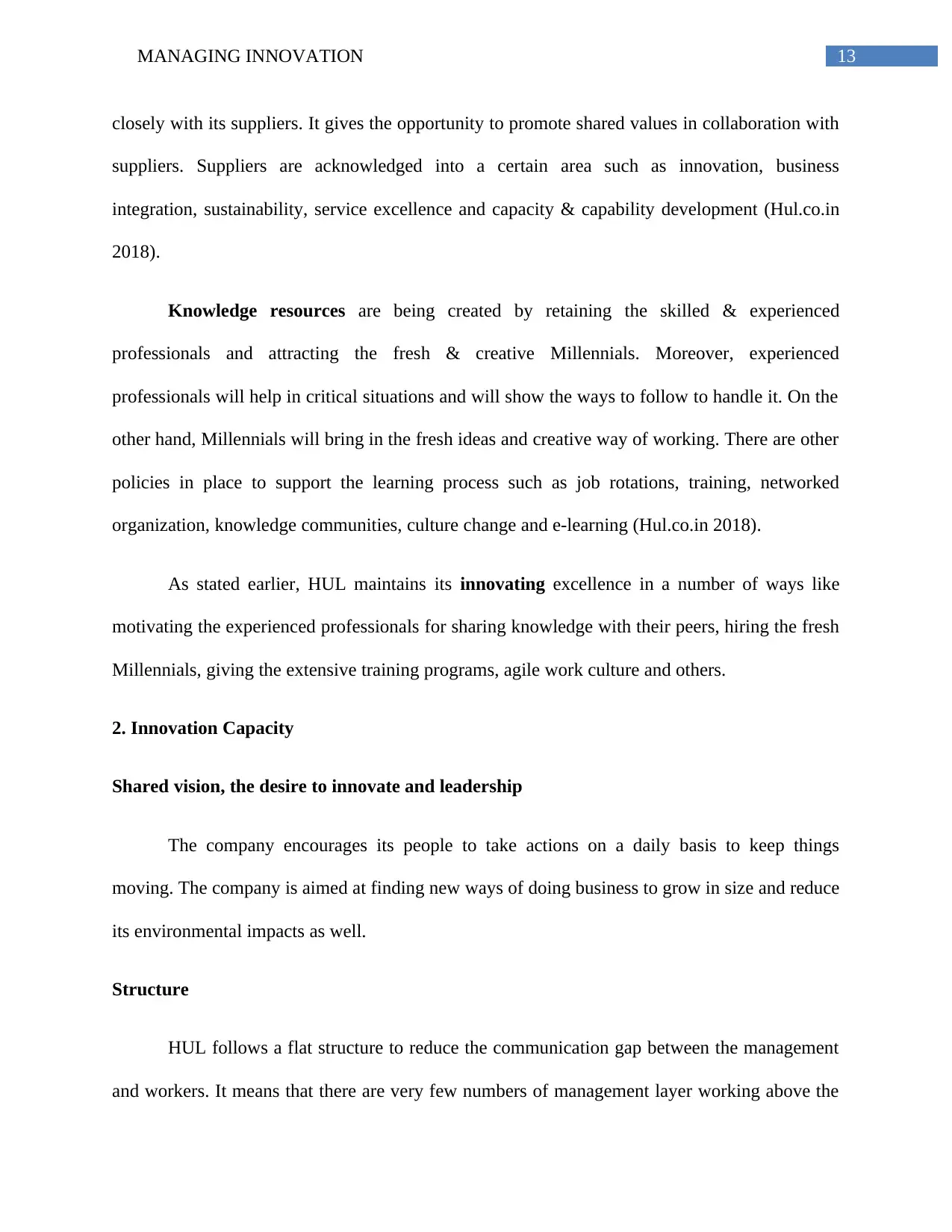
13MANAGING INNOVATION
closely with its suppliers. It gives the opportunity to promote shared values in collaboration with
suppliers. Suppliers are acknowledged into a certain area such as innovation, business
integration, sustainability, service excellence and capacity & capability development (Hul.co.in
2018).
Knowledge resources are being created by retaining the skilled & experienced
professionals and attracting the fresh & creative Millennials. Moreover, experienced
professionals will help in critical situations and will show the ways to follow to handle it. On the
other hand, Millennials will bring in the fresh ideas and creative way of working. There are other
policies in place to support the learning process such as job rotations, training, networked
organization, knowledge communities, culture change and e-learning (Hul.co.in 2018).
As stated earlier, HUL maintains its innovating excellence in a number of ways like
motivating the experienced professionals for sharing knowledge with their peers, hiring the fresh
Millennials, giving the extensive training programs, agile work culture and others.
2. Innovation Capacity
Shared vision, the desire to innovate and leadership
The company encourages its people to take actions on a daily basis to keep things
moving. The company is aimed at finding new ways of doing business to grow in size and reduce
its environmental impacts as well.
Structure
HUL follows a flat structure to reduce the communication gap between the management
and workers. It means that there are very few numbers of management layer working above the
closely with its suppliers. It gives the opportunity to promote shared values in collaboration with
suppliers. Suppliers are acknowledged into a certain area such as innovation, business
integration, sustainability, service excellence and capacity & capability development (Hul.co.in
2018).
Knowledge resources are being created by retaining the skilled & experienced
professionals and attracting the fresh & creative Millennials. Moreover, experienced
professionals will help in critical situations and will show the ways to follow to handle it. On the
other hand, Millennials will bring in the fresh ideas and creative way of working. There are other
policies in place to support the learning process such as job rotations, training, networked
organization, knowledge communities, culture change and e-learning (Hul.co.in 2018).
As stated earlier, HUL maintains its innovating excellence in a number of ways like
motivating the experienced professionals for sharing knowledge with their peers, hiring the fresh
Millennials, giving the extensive training programs, agile work culture and others.
2. Innovation Capacity
Shared vision, the desire to innovate and leadership
The company encourages its people to take actions on a daily basis to keep things
moving. The company is aimed at finding new ways of doing business to grow in size and reduce
its environmental impacts as well.
Structure
HUL follows a flat structure to reduce the communication gap between the management
and workers. It means that there are very few numbers of management layer working above the
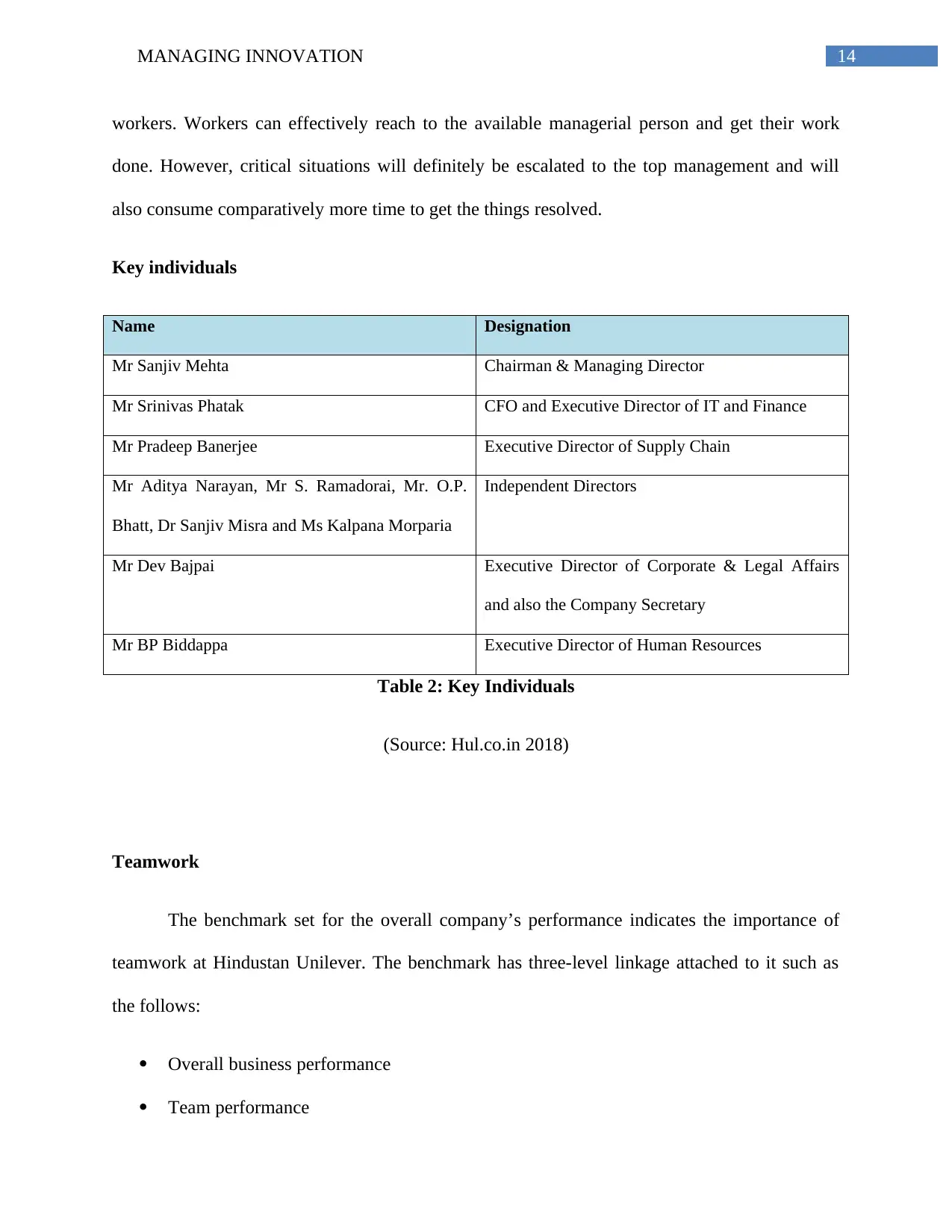
14MANAGING INNOVATION
workers. Workers can effectively reach to the available managerial person and get their work
done. However, critical situations will definitely be escalated to the top management and will
also consume comparatively more time to get the things resolved.
Key individuals
Name Designation
Mr Sanjiv Mehta Chairman & Managing Director
Mr Srinivas Phatak CFO and Executive Director of IT and Finance
Mr Pradeep Banerjee Executive Director of Supply Chain
Mr Aditya Narayan, Mr S. Ramadorai, Mr. O.P.
Bhatt, Dr Sanjiv Misra and Ms Kalpana Morparia
Independent Directors
Mr Dev Bajpai Executive Director of Corporate & Legal Affairs
and also the Company Secretary
Mr BP Biddappa Executive Director of Human Resources
Table 2: Key Individuals
(Source: Hul.co.in 2018)
Teamwork
The benchmark set for the overall company’s performance indicates the importance of
teamwork at Hindustan Unilever. The benchmark has three-level linkage attached to it such as
the follows:
Overall business performance
Team performance
workers. Workers can effectively reach to the available managerial person and get their work
done. However, critical situations will definitely be escalated to the top management and will
also consume comparatively more time to get the things resolved.
Key individuals
Name Designation
Mr Sanjiv Mehta Chairman & Managing Director
Mr Srinivas Phatak CFO and Executive Director of IT and Finance
Mr Pradeep Banerjee Executive Director of Supply Chain
Mr Aditya Narayan, Mr S. Ramadorai, Mr. O.P.
Bhatt, Dr Sanjiv Misra and Ms Kalpana Morparia
Independent Directors
Mr Dev Bajpai Executive Director of Corporate & Legal Affairs
and also the Company Secretary
Mr BP Biddappa Executive Director of Human Resources
Table 2: Key Individuals
(Source: Hul.co.in 2018)
Teamwork
The benchmark set for the overall company’s performance indicates the importance of
teamwork at Hindustan Unilever. The benchmark has three-level linkage attached to it such as
the follows:
Overall business performance
Team performance
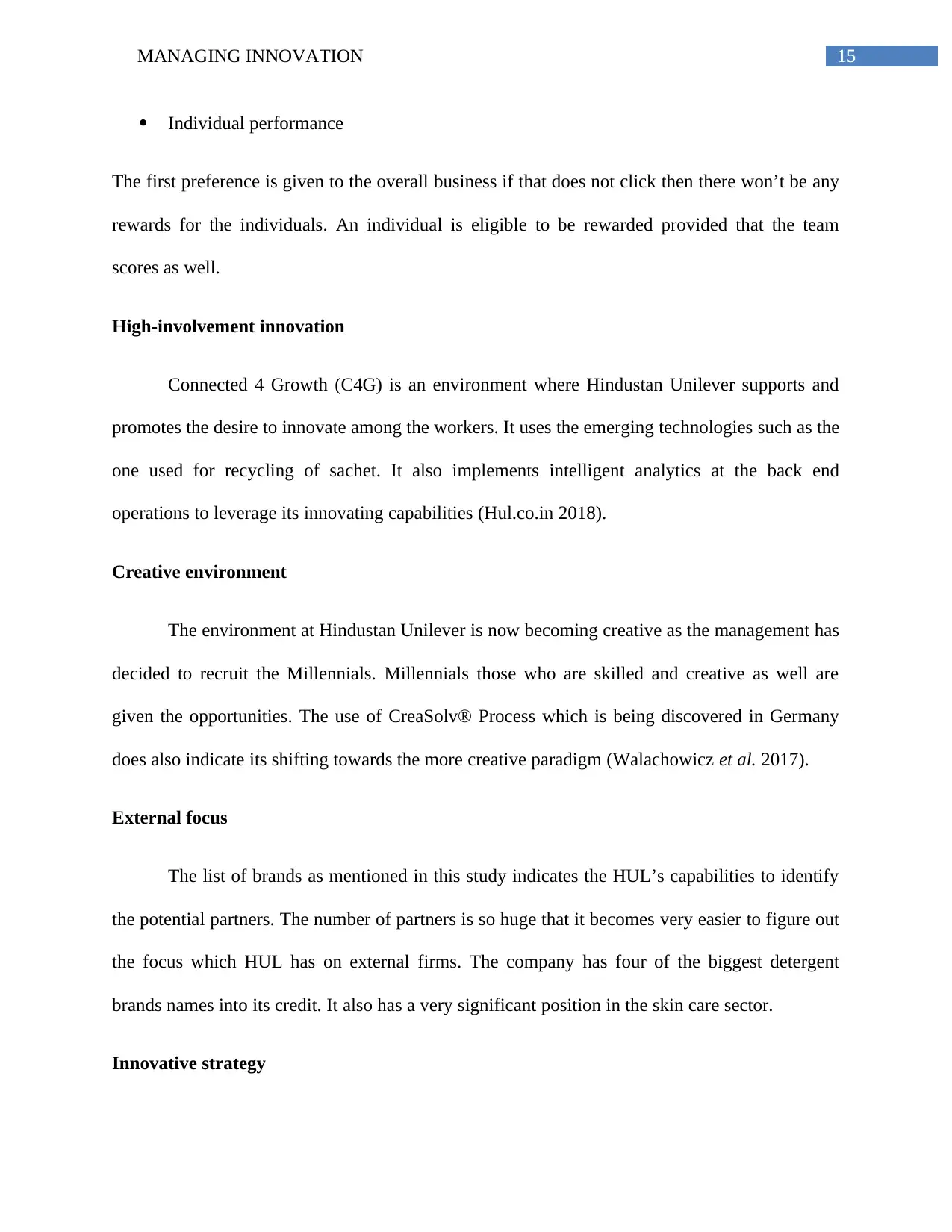
15MANAGING INNOVATION
Individual performance
The first preference is given to the overall business if that does not click then there won’t be any
rewards for the individuals. An individual is eligible to be rewarded provided that the team
scores as well.
High-involvement innovation
Connected 4 Growth (C4G) is an environment where Hindustan Unilever supports and
promotes the desire to innovate among the workers. It uses the emerging technologies such as the
one used for recycling of sachet. It also implements intelligent analytics at the back end
operations to leverage its innovating capabilities (Hul.co.in 2018).
Creative environment
The environment at Hindustan Unilever is now becoming creative as the management has
decided to recruit the Millennials. Millennials those who are skilled and creative as well are
given the opportunities. The use of CreaSolv® Process which is being discovered in Germany
does also indicate its shifting towards the more creative paradigm (Walachowicz et al. 2017).
External focus
The list of brands as mentioned in this study indicates the HUL’s capabilities to identify
the potential partners. The number of partners is so huge that it becomes very easier to figure out
the focus which HUL has on external firms. The company has four of the biggest detergent
brands names into its credit. It also has a very significant position in the skin care sector.
Innovative strategy
Individual performance
The first preference is given to the overall business if that does not click then there won’t be any
rewards for the individuals. An individual is eligible to be rewarded provided that the team
scores as well.
High-involvement innovation
Connected 4 Growth (C4G) is an environment where Hindustan Unilever supports and
promotes the desire to innovate among the workers. It uses the emerging technologies such as the
one used for recycling of sachet. It also implements intelligent analytics at the back end
operations to leverage its innovating capabilities (Hul.co.in 2018).
Creative environment
The environment at Hindustan Unilever is now becoming creative as the management has
decided to recruit the Millennials. Millennials those who are skilled and creative as well are
given the opportunities. The use of CreaSolv® Process which is being discovered in Germany
does also indicate its shifting towards the more creative paradigm (Walachowicz et al. 2017).
External focus
The list of brands as mentioned in this study indicates the HUL’s capabilities to identify
the potential partners. The number of partners is so huge that it becomes very easier to figure out
the focus which HUL has on external firms. The company has four of the biggest detergent
brands names into its credit. It also has a very significant position in the skin care sector.
Innovative strategy
Secure Best Marks with AI Grader
Need help grading? Try our AI Grader for instant feedback on your assignments.
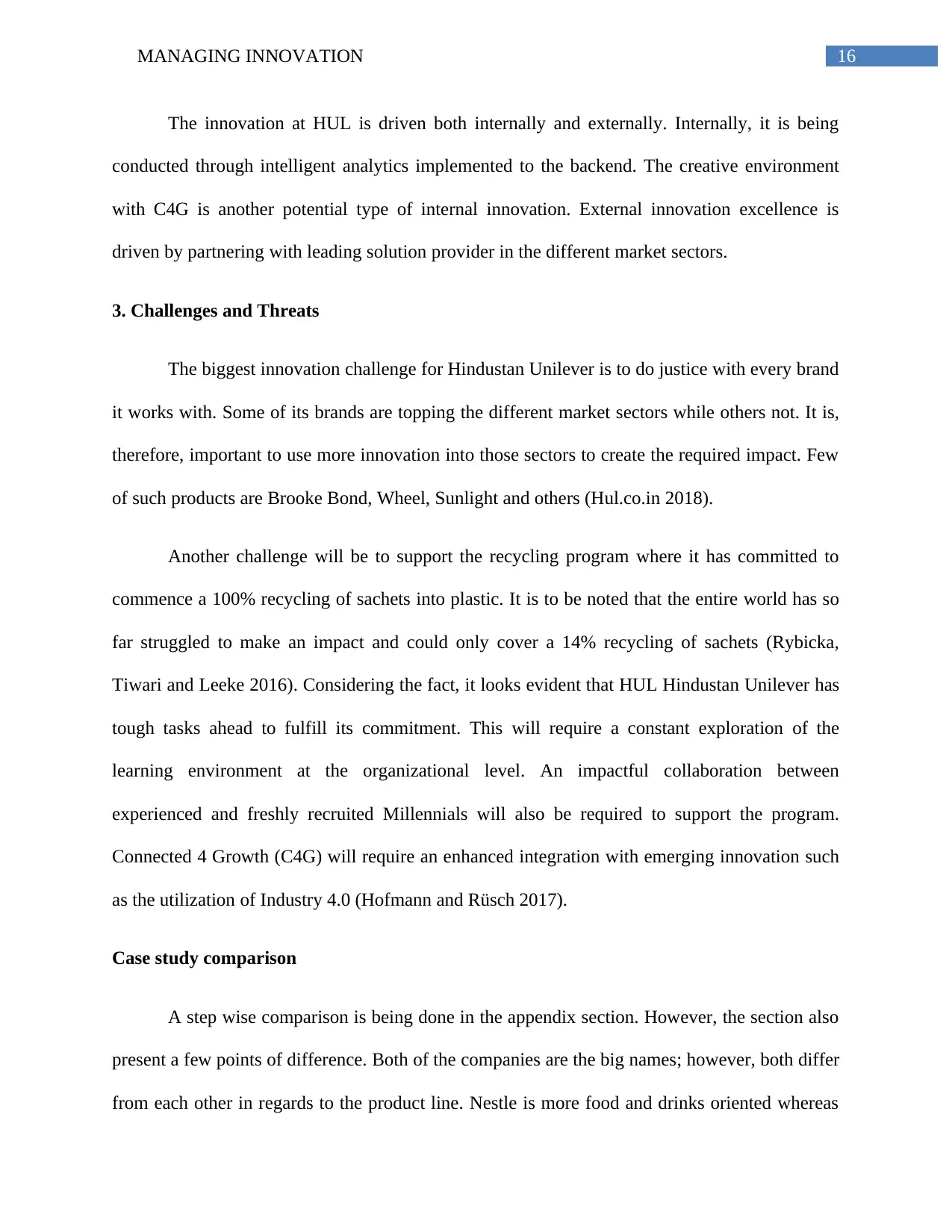
16MANAGING INNOVATION
The innovation at HUL is driven both internally and externally. Internally, it is being
conducted through intelligent analytics implemented to the backend. The creative environment
with C4G is another potential type of internal innovation. External innovation excellence is
driven by partnering with leading solution provider in the different market sectors.
3. Challenges and Threats
The biggest innovation challenge for Hindustan Unilever is to do justice with every brand
it works with. Some of its brands are topping the different market sectors while others not. It is,
therefore, important to use more innovation into those sectors to create the required impact. Few
of such products are Brooke Bond, Wheel, Sunlight and others (Hul.co.in 2018).
Another challenge will be to support the recycling program where it has committed to
commence a 100% recycling of sachets into plastic. It is to be noted that the entire world has so
far struggled to make an impact and could only cover a 14% recycling of sachets (Rybicka,
Tiwari and Leeke 2016). Considering the fact, it looks evident that HUL Hindustan Unilever has
tough tasks ahead to fulfill its commitment. This will require a constant exploration of the
learning environment at the organizational level. An impactful collaboration between
experienced and freshly recruited Millennials will also be required to support the program.
Connected 4 Growth (C4G) will require an enhanced integration with emerging innovation such
as the utilization of Industry 4.0 (Hofmann and Rüsch 2017).
Case study comparison
A step wise comparison is being done in the appendix section. However, the section also
present a few points of difference. Both of the companies are the big names; however, both differ
from each other in regards to the product line. Nestle is more food and drinks oriented whereas
The innovation at HUL is driven both internally and externally. Internally, it is being
conducted through intelligent analytics implemented to the backend. The creative environment
with C4G is another potential type of internal innovation. External innovation excellence is
driven by partnering with leading solution provider in the different market sectors.
3. Challenges and Threats
The biggest innovation challenge for Hindustan Unilever is to do justice with every brand
it works with. Some of its brands are topping the different market sectors while others not. It is,
therefore, important to use more innovation into those sectors to create the required impact. Few
of such products are Brooke Bond, Wheel, Sunlight and others (Hul.co.in 2018).
Another challenge will be to support the recycling program where it has committed to
commence a 100% recycling of sachets into plastic. It is to be noted that the entire world has so
far struggled to make an impact and could only cover a 14% recycling of sachets (Rybicka,
Tiwari and Leeke 2016). Considering the fact, it looks evident that HUL Hindustan Unilever has
tough tasks ahead to fulfill its commitment. This will require a constant exploration of the
learning environment at the organizational level. An impactful collaboration between
experienced and freshly recruited Millennials will also be required to support the program.
Connected 4 Growth (C4G) will require an enhanced integration with emerging innovation such
as the utilization of Industry 4.0 (Hofmann and Rüsch 2017).
Case study comparison
A step wise comparison is being done in the appendix section. However, the section also
present a few points of difference. Both of the companies are the big names; however, both differ
from each other in regards to the product line. Nestle is more food and drinks oriented whereas
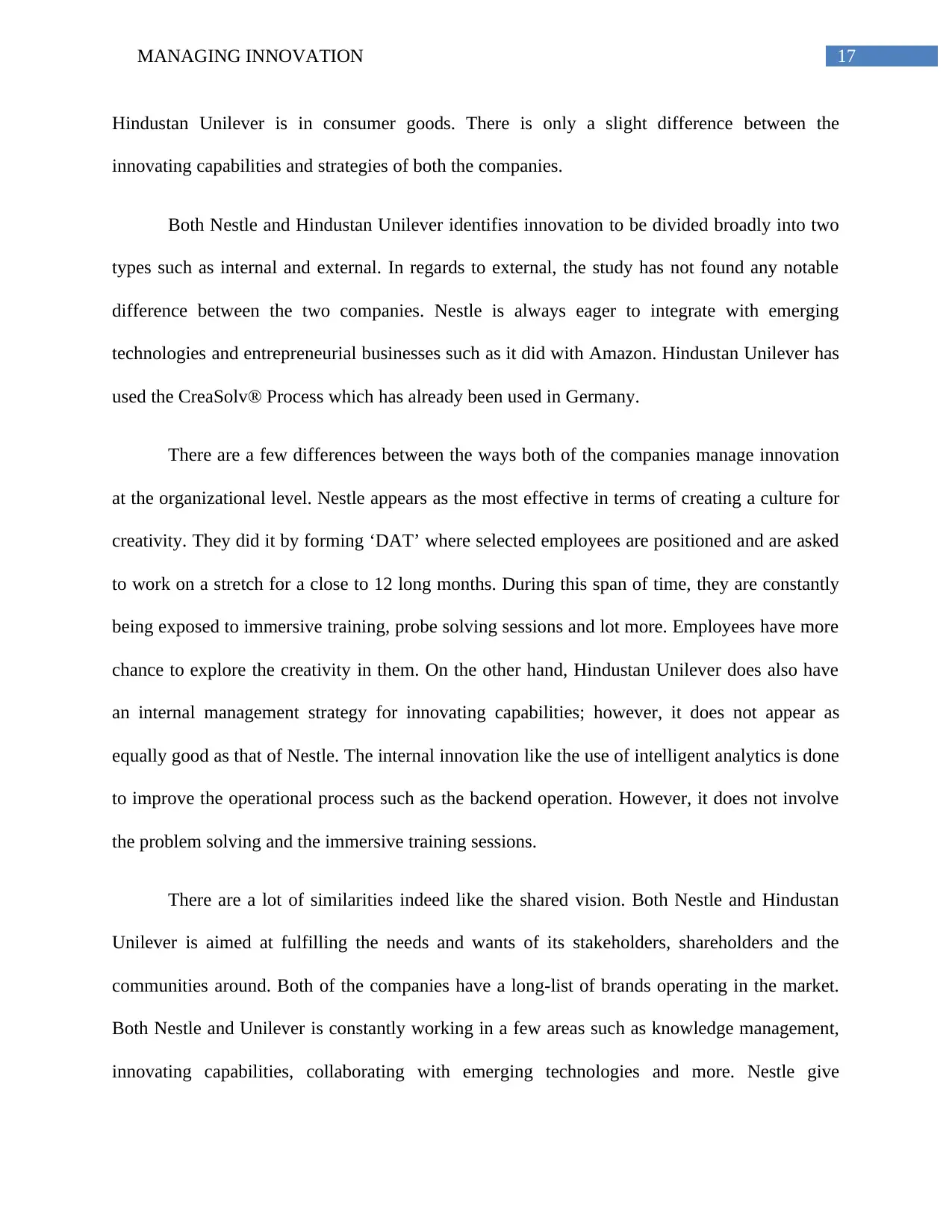
17MANAGING INNOVATION
Hindustan Unilever is in consumer goods. There is only a slight difference between the
innovating capabilities and strategies of both the companies.
Both Nestle and Hindustan Unilever identifies innovation to be divided broadly into two
types such as internal and external. In regards to external, the study has not found any notable
difference between the two companies. Nestle is always eager to integrate with emerging
technologies and entrepreneurial businesses such as it did with Amazon. Hindustan Unilever has
used the CreaSolv® Process which has already been used in Germany.
There are a few differences between the ways both of the companies manage innovation
at the organizational level. Nestle appears as the most effective in terms of creating a culture for
creativity. They did it by forming ‘DAT’ where selected employees are positioned and are asked
to work on a stretch for a close to 12 long months. During this span of time, they are constantly
being exposed to immersive training, probe solving sessions and lot more. Employees have more
chance to explore the creativity in them. On the other hand, Hindustan Unilever does also have
an internal management strategy for innovating capabilities; however, it does not appear as
equally good as that of Nestle. The internal innovation like the use of intelligent analytics is done
to improve the operational process such as the backend operation. However, it does not involve
the problem solving and the immersive training sessions.
There are a lot of similarities indeed like the shared vision. Both Nestle and Hindustan
Unilever is aimed at fulfilling the needs and wants of its stakeholders, shareholders and the
communities around. Both of the companies have a long-list of brands operating in the market.
Both Nestle and Unilever is constantly working in a few areas such as knowledge management,
innovating capabilities, collaborating with emerging technologies and more. Nestle give
Hindustan Unilever is in consumer goods. There is only a slight difference between the
innovating capabilities and strategies of both the companies.
Both Nestle and Hindustan Unilever identifies innovation to be divided broadly into two
types such as internal and external. In regards to external, the study has not found any notable
difference between the two companies. Nestle is always eager to integrate with emerging
technologies and entrepreneurial businesses such as it did with Amazon. Hindustan Unilever has
used the CreaSolv® Process which has already been used in Germany.
There are a few differences between the ways both of the companies manage innovation
at the organizational level. Nestle appears as the most effective in terms of creating a culture for
creativity. They did it by forming ‘DAT’ where selected employees are positioned and are asked
to work on a stretch for a close to 12 long months. During this span of time, they are constantly
being exposed to immersive training, probe solving sessions and lot more. Employees have more
chance to explore the creativity in them. On the other hand, Hindustan Unilever does also have
an internal management strategy for innovating capabilities; however, it does not appear as
equally good as that of Nestle. The internal innovation like the use of intelligent analytics is done
to improve the operational process such as the backend operation. However, it does not involve
the problem solving and the immersive training sessions.
There are a lot of similarities indeed like the shared vision. Both Nestle and Hindustan
Unilever is aimed at fulfilling the needs and wants of its stakeholders, shareholders and the
communities around. Both of the companies have a long-list of brands operating in the market.
Both Nestle and Unilever is constantly working in a few areas such as knowledge management,
innovating capabilities, collaborating with emerging technologies and more. Nestle give
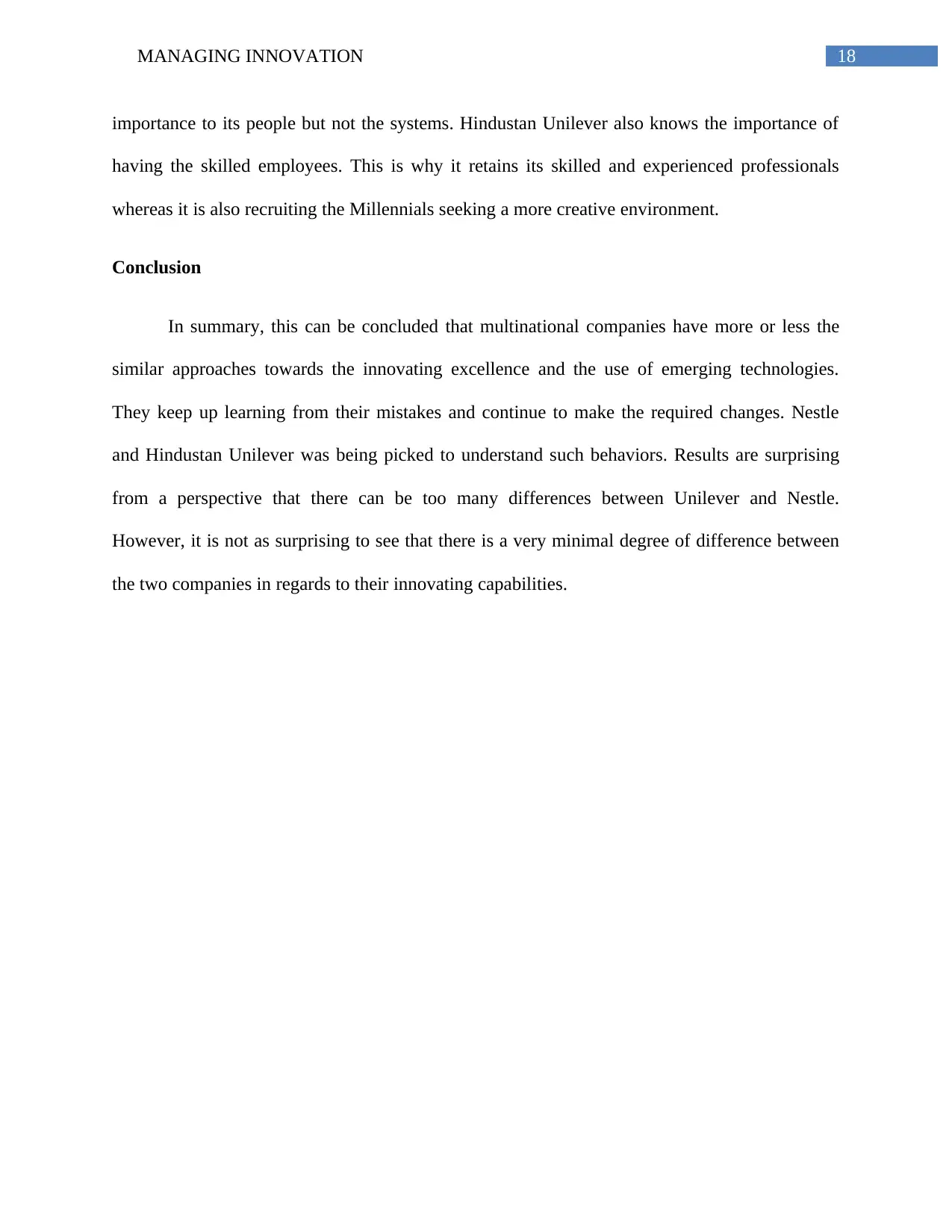
18MANAGING INNOVATION
importance to its people but not the systems. Hindustan Unilever also knows the importance of
having the skilled employees. This is why it retains its skilled and experienced professionals
whereas it is also recruiting the Millennials seeking a more creative environment.
Conclusion
In summary, this can be concluded that multinational companies have more or less the
similar approaches towards the innovating excellence and the use of emerging technologies.
They keep up learning from their mistakes and continue to make the required changes. Nestle
and Hindustan Unilever was being picked to understand such behaviors. Results are surprising
from a perspective that there can be too many differences between Unilever and Nestle.
However, it is not as surprising to see that there is a very minimal degree of difference between
the two companies in regards to their innovating capabilities.
importance to its people but not the systems. Hindustan Unilever also knows the importance of
having the skilled employees. This is why it retains its skilled and experienced professionals
whereas it is also recruiting the Millennials seeking a more creative environment.
Conclusion
In summary, this can be concluded that multinational companies have more or less the
similar approaches towards the innovating excellence and the use of emerging technologies.
They keep up learning from their mistakes and continue to make the required changes. Nestle
and Hindustan Unilever was being picked to understand such behaviors. Results are surprising
from a perspective that there can be too many differences between Unilever and Nestle.
However, it is not as surprising to see that there is a very minimal degree of difference between
the two companies in regards to their innovating capabilities.
Paraphrase This Document
Need a fresh take? Get an instant paraphrase of this document with our AI Paraphraser
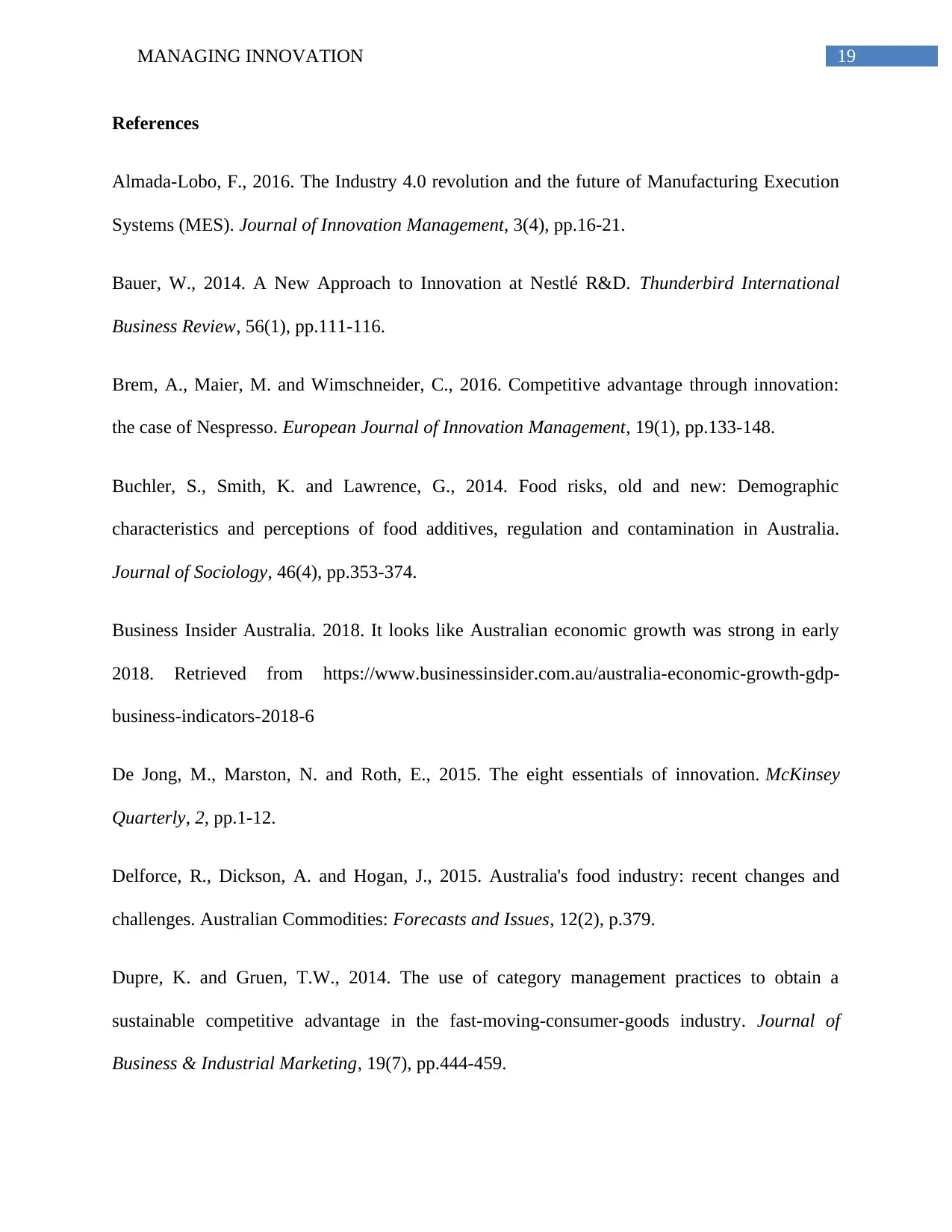
19MANAGING INNOVATION
References
Almada-Lobo, F., 2016. The Industry 4.0 revolution and the future of Manufacturing Execution
Systems (MES). Journal of Innovation Management, 3(4), pp.16-21.
Bauer, W., 2014. A New Approach to Innovation at Nestlé R&D. Thunderbird International
Business Review, 56(1), pp.111-116.
Brem, A., Maier, M. and Wimschneider, C., 2016. Competitive advantage through innovation:
the case of Nespresso. European Journal of Innovation Management, 19(1), pp.133-148.
Buchler, S., Smith, K. and Lawrence, G., 2014. Food risks, old and new: Demographic
characteristics and perceptions of food additives, regulation and contamination in Australia.
Journal of Sociology, 46(4), pp.353-374.
Business Insider Australia. 2018. It looks like Australian economic growth was strong in early
2018. Retrieved from https://www.businessinsider.com.au/australia-economic-growth-gdp-
business-indicators-2018-6
De Jong, M., Marston, N. and Roth, E., 2015. The eight essentials of innovation. McKinsey
Quarterly, 2, pp.1-12.
Delforce, R., Dickson, A. and Hogan, J., 2015. Australia's food industry: recent changes and
challenges. Australian Commodities: Forecasts and Issues, 12(2), p.379.
Dupre, K. and Gruen, T.W., 2014. The use of category management practices to obtain a
sustainable competitive advantage in the fast-moving-consumer-goods industry. Journal of
Business & Industrial Marketing, 19(7), pp.444-459.
References
Almada-Lobo, F., 2016. The Industry 4.0 revolution and the future of Manufacturing Execution
Systems (MES). Journal of Innovation Management, 3(4), pp.16-21.
Bauer, W., 2014. A New Approach to Innovation at Nestlé R&D. Thunderbird International
Business Review, 56(1), pp.111-116.
Brem, A., Maier, M. and Wimschneider, C., 2016. Competitive advantage through innovation:
the case of Nespresso. European Journal of Innovation Management, 19(1), pp.133-148.
Buchler, S., Smith, K. and Lawrence, G., 2014. Food risks, old and new: Demographic
characteristics and perceptions of food additives, regulation and contamination in Australia.
Journal of Sociology, 46(4), pp.353-374.
Business Insider Australia. 2018. It looks like Australian economic growth was strong in early
2018. Retrieved from https://www.businessinsider.com.au/australia-economic-growth-gdp-
business-indicators-2018-6
De Jong, M., Marston, N. and Roth, E., 2015. The eight essentials of innovation. McKinsey
Quarterly, 2, pp.1-12.
Delforce, R., Dickson, A. and Hogan, J., 2015. Australia's food industry: recent changes and
challenges. Australian Commodities: Forecasts and Issues, 12(2), p.379.
Dupre, K. and Gruen, T.W., 2014. The use of category management practices to obtain a
sustainable competitive advantage in the fast-moving-consumer-goods industry. Journal of
Business & Industrial Marketing, 19(7), pp.444-459.
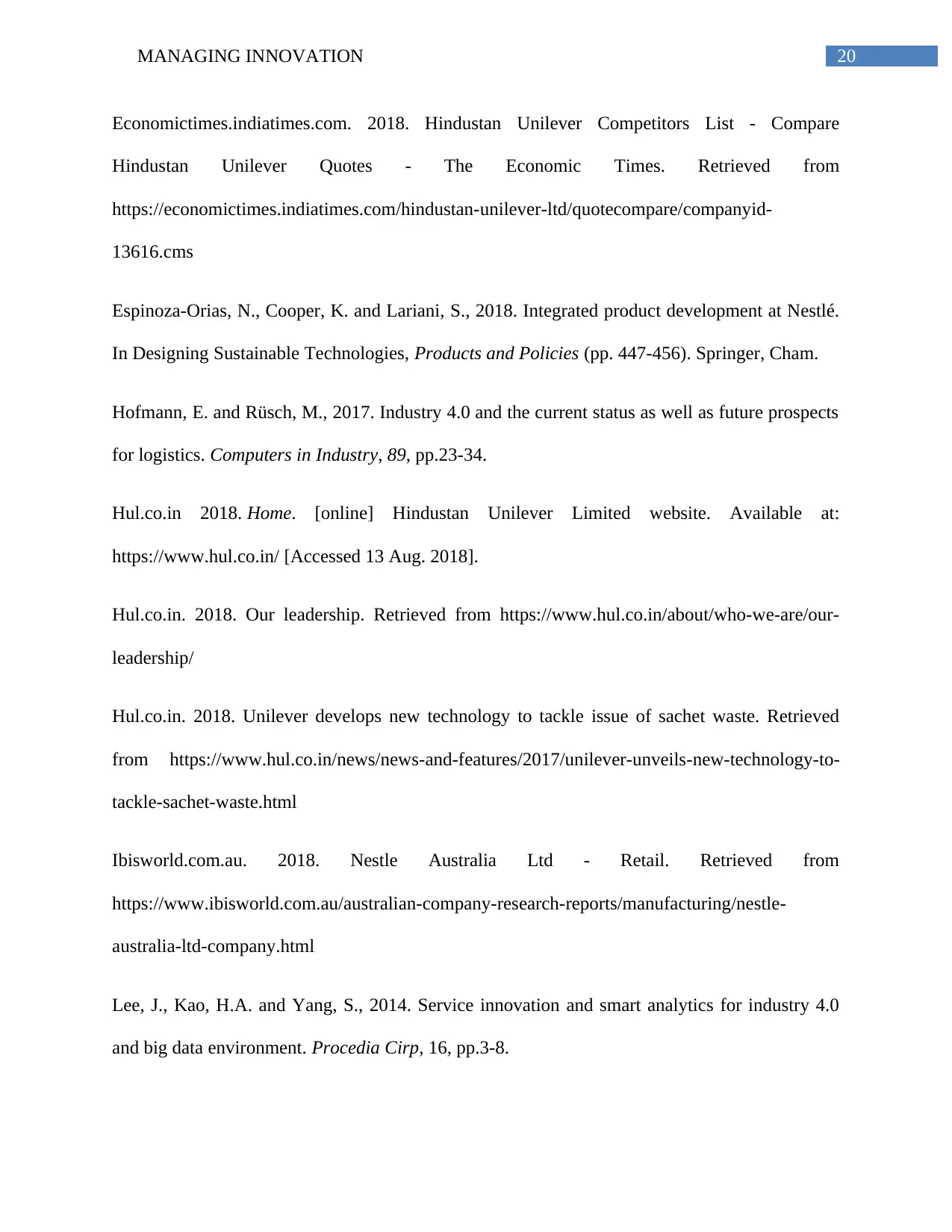
20MANAGING INNOVATION
Economictimes.indiatimes.com. 2018. Hindustan Unilever Competitors List - Compare
Hindustan Unilever Quotes - The Economic Times. Retrieved from
https://economictimes.indiatimes.com/hindustan-unilever-ltd/quotecompare/companyid-
13616.cms
Espinoza-Orias, N., Cooper, K. and Lariani, S., 2018. Integrated product development at Nestlé.
In Designing Sustainable Technologies, Products and Policies (pp. 447-456). Springer, Cham.
Hofmann, E. and Rüsch, M., 2017. Industry 4.0 and the current status as well as future prospects
for logistics. Computers in Industry, 89, pp.23-34.
Hul.co.in 2018. Home. [online] Hindustan Unilever Limited website. Available at:
https://www.hul.co.in/ [Accessed 13 Aug. 2018].
Hul.co.in. 2018. Our leadership. Retrieved from https://www.hul.co.in/about/who-we-are/our-
leadership/
Hul.co.in. 2018. Unilever develops new technology to tackle issue of sachet waste. Retrieved
from https://www.hul.co.in/news/news-and-features/2017/unilever-unveils-new-technology-to-
tackle-sachet-waste.html
Ibisworld.com.au. 2018. Nestle Australia Ltd - Retail. Retrieved from
https://www.ibisworld.com.au/australian-company-research-reports/manufacturing/nestle-
australia-ltd-company.html
Lee, J., Kao, H.A. and Yang, S., 2014. Service innovation and smart analytics for industry 4.0
and big data environment. Procedia Cirp, 16, pp.3-8.
Economictimes.indiatimes.com. 2018. Hindustan Unilever Competitors List - Compare
Hindustan Unilever Quotes - The Economic Times. Retrieved from
https://economictimes.indiatimes.com/hindustan-unilever-ltd/quotecompare/companyid-
13616.cms
Espinoza-Orias, N., Cooper, K. and Lariani, S., 2018. Integrated product development at Nestlé.
In Designing Sustainable Technologies, Products and Policies (pp. 447-456). Springer, Cham.
Hofmann, E. and Rüsch, M., 2017. Industry 4.0 and the current status as well as future prospects
for logistics. Computers in Industry, 89, pp.23-34.
Hul.co.in 2018. Home. [online] Hindustan Unilever Limited website. Available at:
https://www.hul.co.in/ [Accessed 13 Aug. 2018].
Hul.co.in. 2018. Our leadership. Retrieved from https://www.hul.co.in/about/who-we-are/our-
leadership/
Hul.co.in. 2018. Unilever develops new technology to tackle issue of sachet waste. Retrieved
from https://www.hul.co.in/news/news-and-features/2017/unilever-unveils-new-technology-to-
tackle-sachet-waste.html
Ibisworld.com.au. 2018. Nestle Australia Ltd - Retail. Retrieved from
https://www.ibisworld.com.au/australian-company-research-reports/manufacturing/nestle-
australia-ltd-company.html
Lee, J., Kao, H.A. and Yang, S., 2014. Service innovation and smart analytics for industry 4.0
and big data environment. Procedia Cirp, 16, pp.3-8.
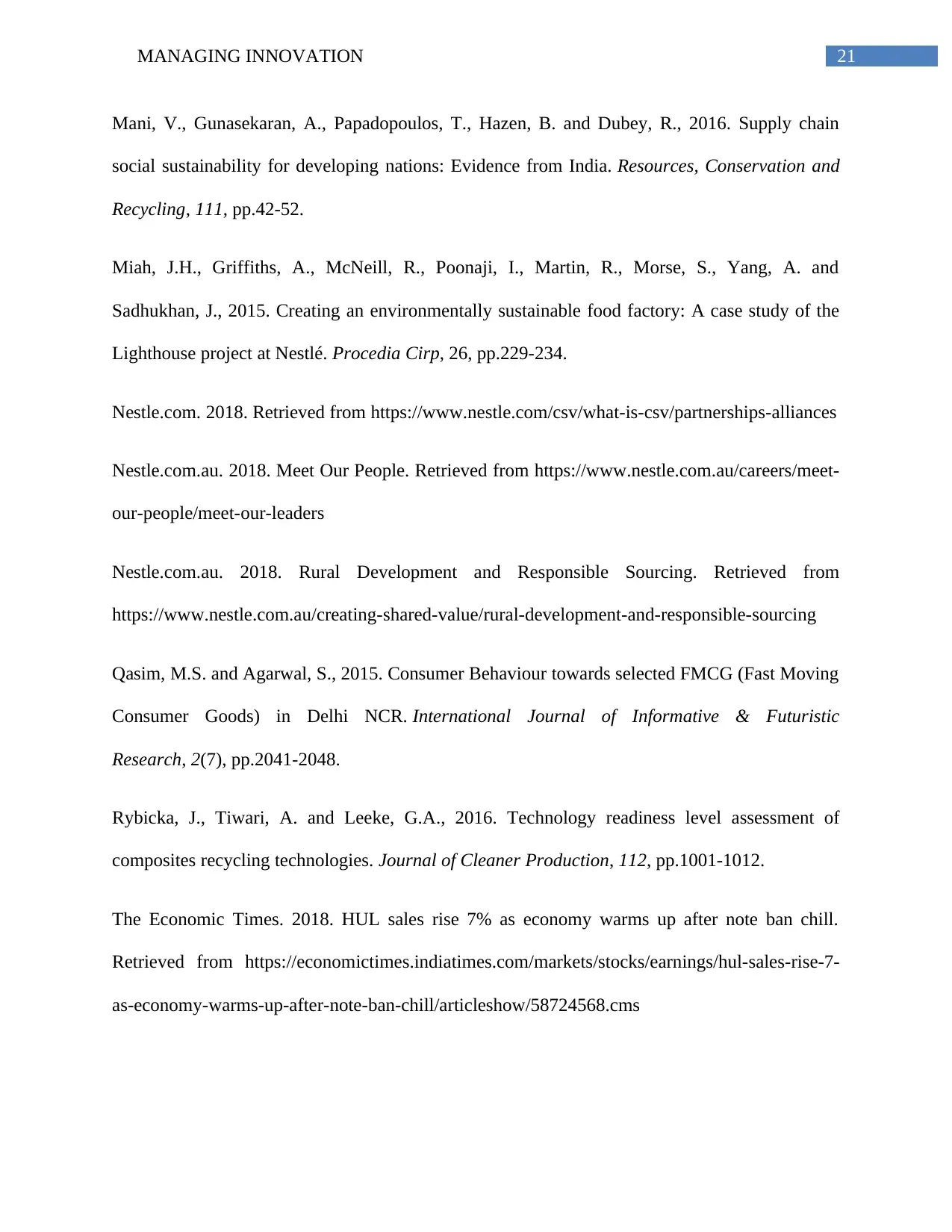
21MANAGING INNOVATION
Mani, V., Gunasekaran, A., Papadopoulos, T., Hazen, B. and Dubey, R., 2016. Supply chain
social sustainability for developing nations: Evidence from India. Resources, Conservation and
Recycling, 111, pp.42-52.
Miah, J.H., Griffiths, A., McNeill, R., Poonaji, I., Martin, R., Morse, S., Yang, A. and
Sadhukhan, J., 2015. Creating an environmentally sustainable food factory: A case study of the
Lighthouse project at Nestlé. Procedia Cirp, 26, pp.229-234.
Nestle.com. 2018. Retrieved from https://www.nestle.com/csv/what-is-csv/partnerships-alliances
Nestle.com.au. 2018. Meet Our People. Retrieved from https://www.nestle.com.au/careers/meet-
our-people/meet-our-leaders
Nestle.com.au. 2018. Rural Development and Responsible Sourcing. Retrieved from
https://www.nestle.com.au/creating-shared-value/rural-development-and-responsible-sourcing
Qasim, M.S. and Agarwal, S., 2015. Consumer Behaviour towards selected FMCG (Fast Moving
Consumer Goods) in Delhi NCR. International Journal of Informative & Futuristic
Research, 2(7), pp.2041-2048.
Rybicka, J., Tiwari, A. and Leeke, G.A., 2016. Technology readiness level assessment of
composites recycling technologies. Journal of Cleaner Production, 112, pp.1001-1012.
The Economic Times. 2018. HUL sales rise 7% as economy warms up after note ban chill.
Retrieved from https://economictimes.indiatimes.com/markets/stocks/earnings/hul-sales-rise-7-
as-economy-warms-up-after-note-ban-chill/articleshow/58724568.cms
Mani, V., Gunasekaran, A., Papadopoulos, T., Hazen, B. and Dubey, R., 2016. Supply chain
social sustainability for developing nations: Evidence from India. Resources, Conservation and
Recycling, 111, pp.42-52.
Miah, J.H., Griffiths, A., McNeill, R., Poonaji, I., Martin, R., Morse, S., Yang, A. and
Sadhukhan, J., 2015. Creating an environmentally sustainable food factory: A case study of the
Lighthouse project at Nestlé. Procedia Cirp, 26, pp.229-234.
Nestle.com. 2018. Retrieved from https://www.nestle.com/csv/what-is-csv/partnerships-alliances
Nestle.com.au. 2018. Meet Our People. Retrieved from https://www.nestle.com.au/careers/meet-
our-people/meet-our-leaders
Nestle.com.au. 2018. Rural Development and Responsible Sourcing. Retrieved from
https://www.nestle.com.au/creating-shared-value/rural-development-and-responsible-sourcing
Qasim, M.S. and Agarwal, S., 2015. Consumer Behaviour towards selected FMCG (Fast Moving
Consumer Goods) in Delhi NCR. International Journal of Informative & Futuristic
Research, 2(7), pp.2041-2048.
Rybicka, J., Tiwari, A. and Leeke, G.A., 2016. Technology readiness level assessment of
composites recycling technologies. Journal of Cleaner Production, 112, pp.1001-1012.
The Economic Times. 2018. HUL sales rise 7% as economy warms up after note ban chill.
Retrieved from https://economictimes.indiatimes.com/markets/stocks/earnings/hul-sales-rise-7-
as-economy-warms-up-after-note-ban-chill/articleshow/58724568.cms
Secure Best Marks with AI Grader
Need help grading? Try our AI Grader for instant feedback on your assignments.
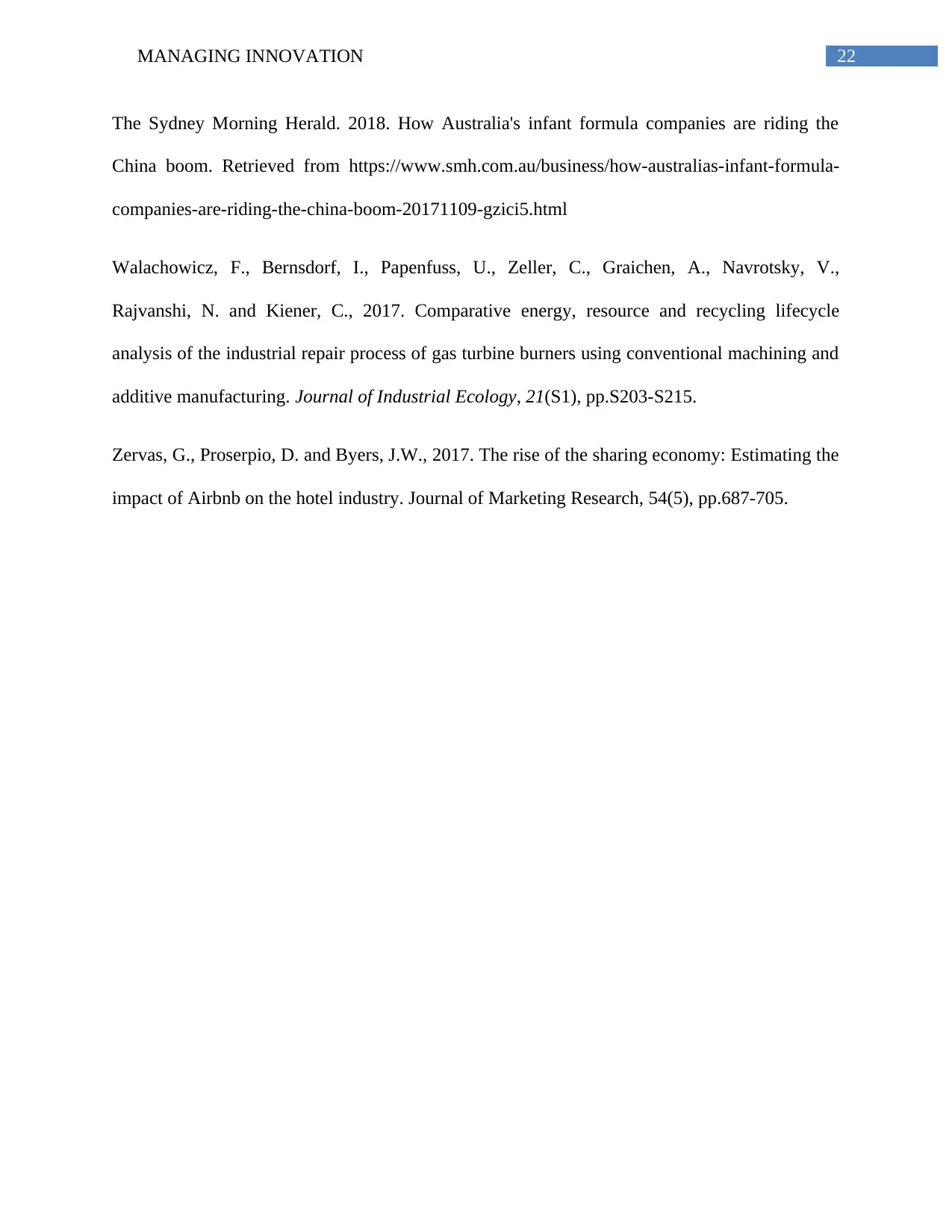
22MANAGING INNOVATION
The Sydney Morning Herald. 2018. How Australia's infant formula companies are riding the
China boom. Retrieved from https://www.smh.com.au/business/how-australias-infant-formula-
companies-are-riding-the-china-boom-20171109-gzici5.html
Walachowicz, F., Bernsdorf, I., Papenfuss, U., Zeller, C., Graichen, A., Navrotsky, V.,
Rajvanshi, N. and Kiener, C., 2017. Comparative energy, resource and recycling lifecycle
analysis of the industrial repair process of gas turbine burners using conventional machining and
additive manufacturing. Journal of Industrial Ecology, 21(S1), pp.S203-S215.
Zervas, G., Proserpio, D. and Byers, J.W., 2017. The rise of the sharing economy: Estimating the
impact of Airbnb on the hotel industry. Journal of Marketing Research, 54(5), pp.687-705.
The Sydney Morning Herald. 2018. How Australia's infant formula companies are riding the
China boom. Retrieved from https://www.smh.com.au/business/how-australias-infant-formula-
companies-are-riding-the-china-boom-20171109-gzici5.html
Walachowicz, F., Bernsdorf, I., Papenfuss, U., Zeller, C., Graichen, A., Navrotsky, V.,
Rajvanshi, N. and Kiener, C., 2017. Comparative energy, resource and recycling lifecycle
analysis of the industrial repair process of gas turbine burners using conventional machining and
additive manufacturing. Journal of Industrial Ecology, 21(S1), pp.S203-S215.
Zervas, G., Proserpio, D. and Byers, J.W., 2017. The rise of the sharing economy: Estimating the
impact of Airbnb on the hotel industry. Journal of Marketing Research, 54(5), pp.687-705.
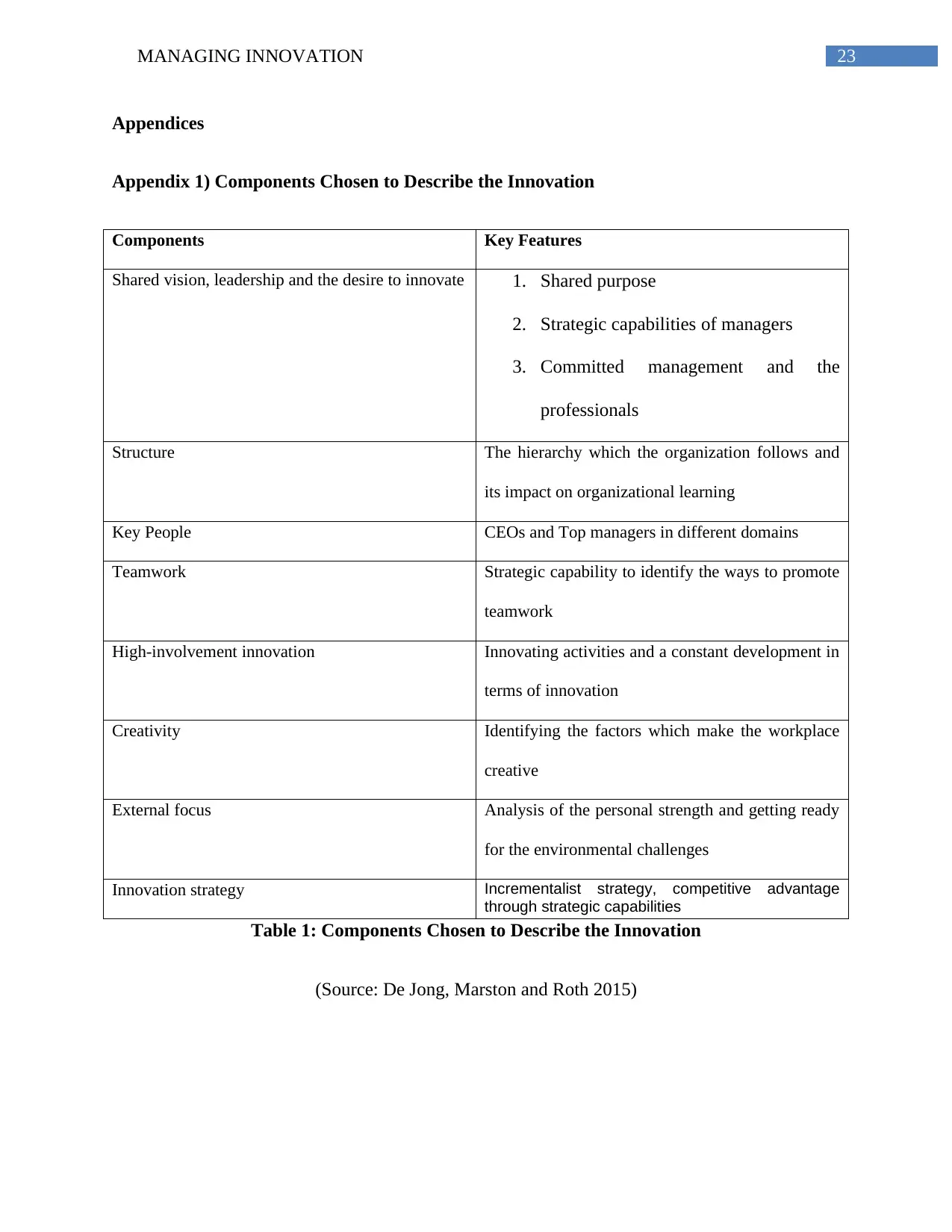
23MANAGING INNOVATION
Appendices
Appendix 1) Components Chosen to Describe the Innovation
Components Key Features
Shared vision, leadership and the desire to innovate 1. Shared purpose
2. Strategic capabilities of managers
3. Committed management and the
professionals
Structure The hierarchy which the organization follows and
its impact on organizational learning
Key People CEOs and Top managers in different domains
Teamwork Strategic capability to identify the ways to promote
teamwork
High-involvement innovation Innovating activities and a constant development in
terms of innovation
Creativity Identifying the factors which make the workplace
creative
External focus Analysis of the personal strength and getting ready
for the environmental challenges
Innovation strategy Incrementalist strategy, competitive advantage
through strategic capabilities
Table 1: Components Chosen to Describe the Innovation
(Source: De Jong, Marston and Roth 2015)
Appendices
Appendix 1) Components Chosen to Describe the Innovation
Components Key Features
Shared vision, leadership and the desire to innovate 1. Shared purpose
2. Strategic capabilities of managers
3. Committed management and the
professionals
Structure The hierarchy which the organization follows and
its impact on organizational learning
Key People CEOs and Top managers in different domains
Teamwork Strategic capability to identify the ways to promote
teamwork
High-involvement innovation Innovating activities and a constant development in
terms of innovation
Creativity Identifying the factors which make the workplace
creative
External focus Analysis of the personal strength and getting ready
for the environmental challenges
Innovation strategy Incrementalist strategy, competitive advantage
through strategic capabilities
Table 1: Components Chosen to Describe the Innovation
(Source: De Jong, Marston and Roth 2015)
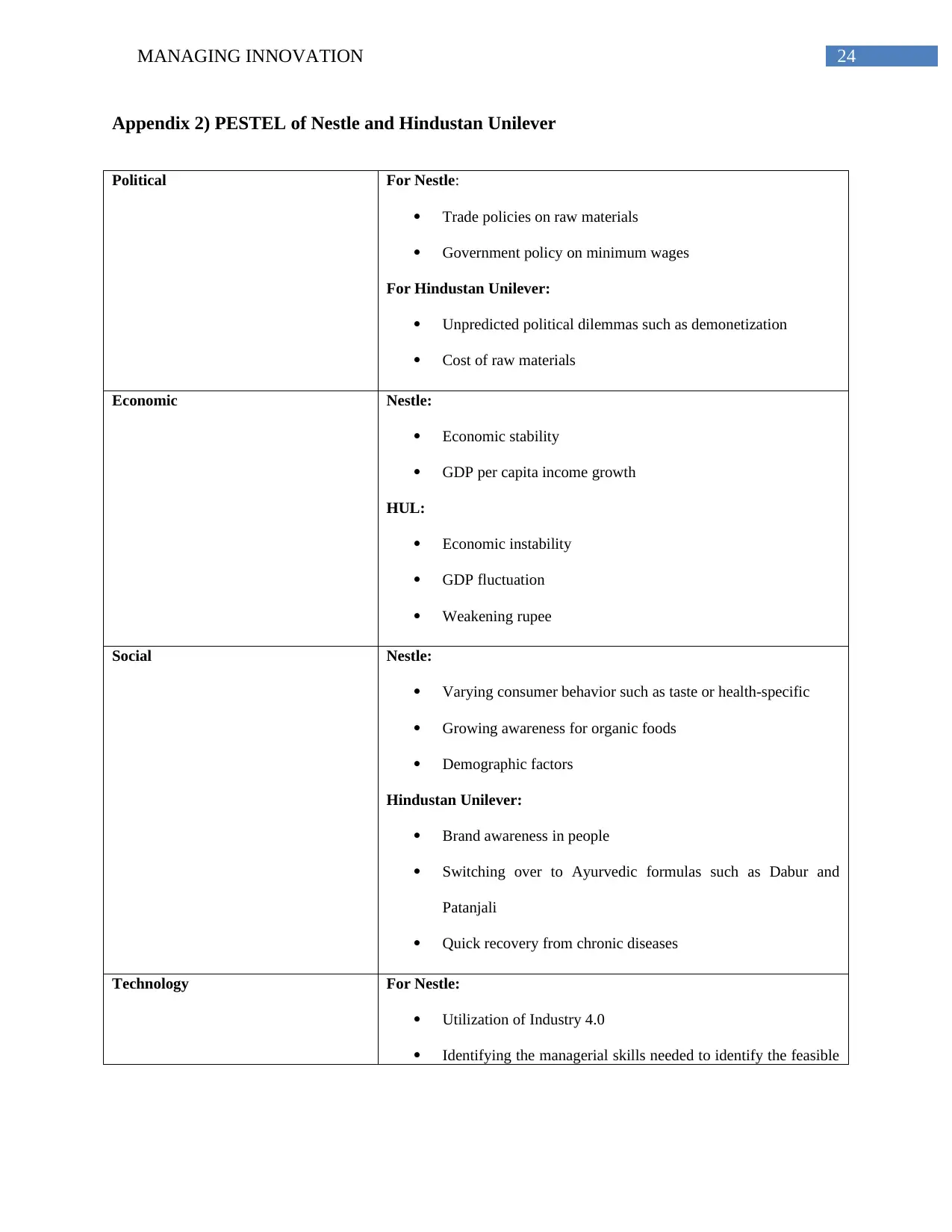
24MANAGING INNOVATION
Appendix 2) PESTEL of Nestle and Hindustan Unilever
Political For Nestle:
Trade policies on raw materials
Government policy on minimum wages
For Hindustan Unilever:
Unpredicted political dilemmas such as demonetization
Cost of raw materials
Economic Nestle:
Economic stability
GDP per capita income growth
HUL:
Economic instability
GDP fluctuation
Weakening rupee
Social Nestle:
Varying consumer behavior such as taste or health-specific
Growing awareness for organic foods
Demographic factors
Hindustan Unilever:
Brand awareness in people
Switching over to Ayurvedic formulas such as Dabur and
Patanjali
Quick recovery from chronic diseases
Technology For Nestle:
Utilization of Industry 4.0
Identifying the managerial skills needed to identify the feasible
Appendix 2) PESTEL of Nestle and Hindustan Unilever
Political For Nestle:
Trade policies on raw materials
Government policy on minimum wages
For Hindustan Unilever:
Unpredicted political dilemmas such as demonetization
Cost of raw materials
Economic Nestle:
Economic stability
GDP per capita income growth
HUL:
Economic instability
GDP fluctuation
Weakening rupee
Social Nestle:
Varying consumer behavior such as taste or health-specific
Growing awareness for organic foods
Demographic factors
Hindustan Unilever:
Brand awareness in people
Switching over to Ayurvedic formulas such as Dabur and
Patanjali
Quick recovery from chronic diseases
Technology For Nestle:
Utilization of Industry 4.0
Identifying the managerial skills needed to identify the feasible
Paraphrase This Document
Need a fresh take? Get an instant paraphrase of this document with our AI Paraphraser
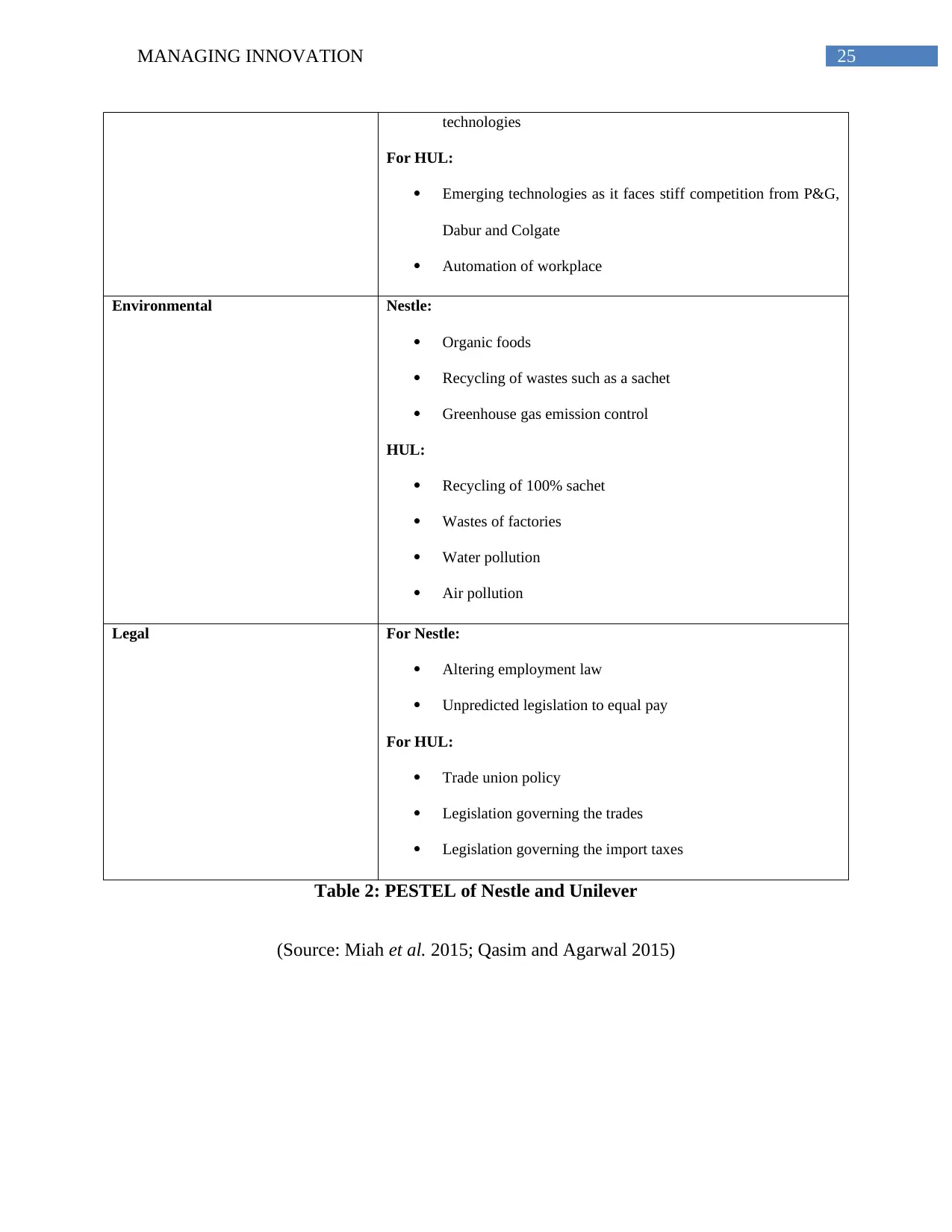
25MANAGING INNOVATION
technologies
For HUL:
Emerging technologies as it faces stiff competition from P&G,
Dabur and Colgate
Automation of workplace
Environmental Nestle:
Organic foods
Recycling of wastes such as a sachet
Greenhouse gas emission control
HUL:
Recycling of 100% sachet
Wastes of factories
Water pollution
Air pollution
Legal For Nestle:
Altering employment law
Unpredicted legislation to equal pay
For HUL:
Trade union policy
Legislation governing the trades
Legislation governing the import taxes
Table 2: PESTEL of Nestle and Unilever
(Source: Miah et al. 2015; Qasim and Agarwal 2015)
technologies
For HUL:
Emerging technologies as it faces stiff competition from P&G,
Dabur and Colgate
Automation of workplace
Environmental Nestle:
Organic foods
Recycling of wastes such as a sachet
Greenhouse gas emission control
HUL:
Recycling of 100% sachet
Wastes of factories
Water pollution
Air pollution
Legal For Nestle:
Altering employment law
Unpredicted legislation to equal pay
For HUL:
Trade union policy
Legislation governing the trades
Legislation governing the import taxes
Table 2: PESTEL of Nestle and Unilever
(Source: Miah et al. 2015; Qasim and Agarwal 2015)
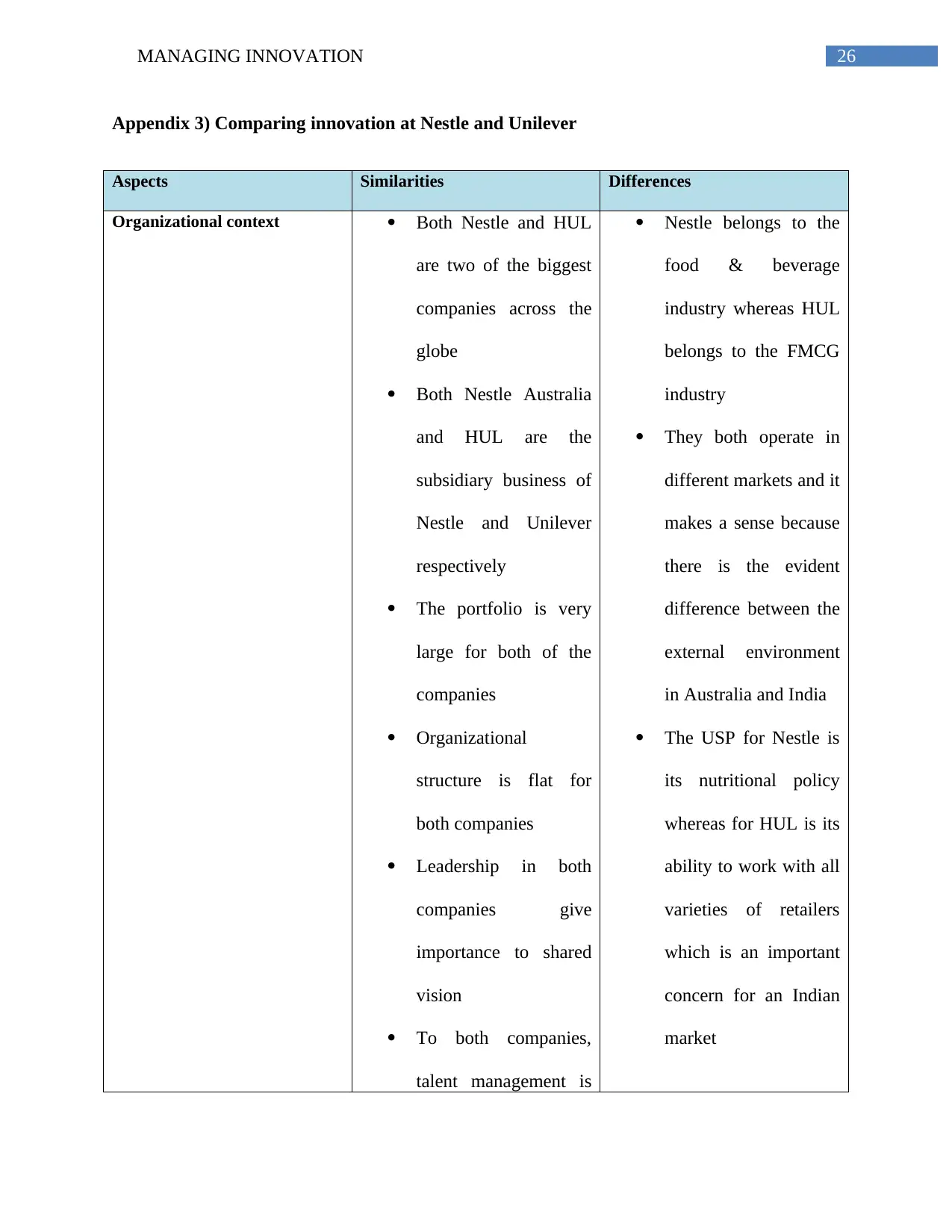
26MANAGING INNOVATION
Appendix 3) Comparing innovation at Nestle and Unilever
Aspects Similarities Differences
Organizational context Both Nestle and HUL
are two of the biggest
companies across the
globe
Both Nestle Australia
and HUL are the
subsidiary business of
Nestle and Unilever
respectively
The portfolio is very
large for both of the
companies
Organizational
structure is flat for
both companies
Leadership in both
companies give
importance to shared
vision
To both companies,
talent management is
Nestle belongs to the
food & beverage
industry whereas HUL
belongs to the FMCG
industry
They both operate in
different markets and it
makes a sense because
there is the evident
difference between the
external environment
in Australia and India
The USP for Nestle is
its nutritional policy
whereas for HUL is its
ability to work with all
varieties of retailers
which is an important
concern for an Indian
market
Appendix 3) Comparing innovation at Nestle and Unilever
Aspects Similarities Differences
Organizational context Both Nestle and HUL
are two of the biggest
companies across the
globe
Both Nestle Australia
and HUL are the
subsidiary business of
Nestle and Unilever
respectively
The portfolio is very
large for both of the
companies
Organizational
structure is flat for
both companies
Leadership in both
companies give
importance to shared
vision
To both companies,
talent management is
Nestle belongs to the
food & beverage
industry whereas HUL
belongs to the FMCG
industry
They both operate in
different markets and it
makes a sense because
there is the evident
difference between the
external environment
in Australia and India
The USP for Nestle is
its nutritional policy
whereas for HUL is its
ability to work with all
varieties of retailers
which is an important
concern for an Indian
market
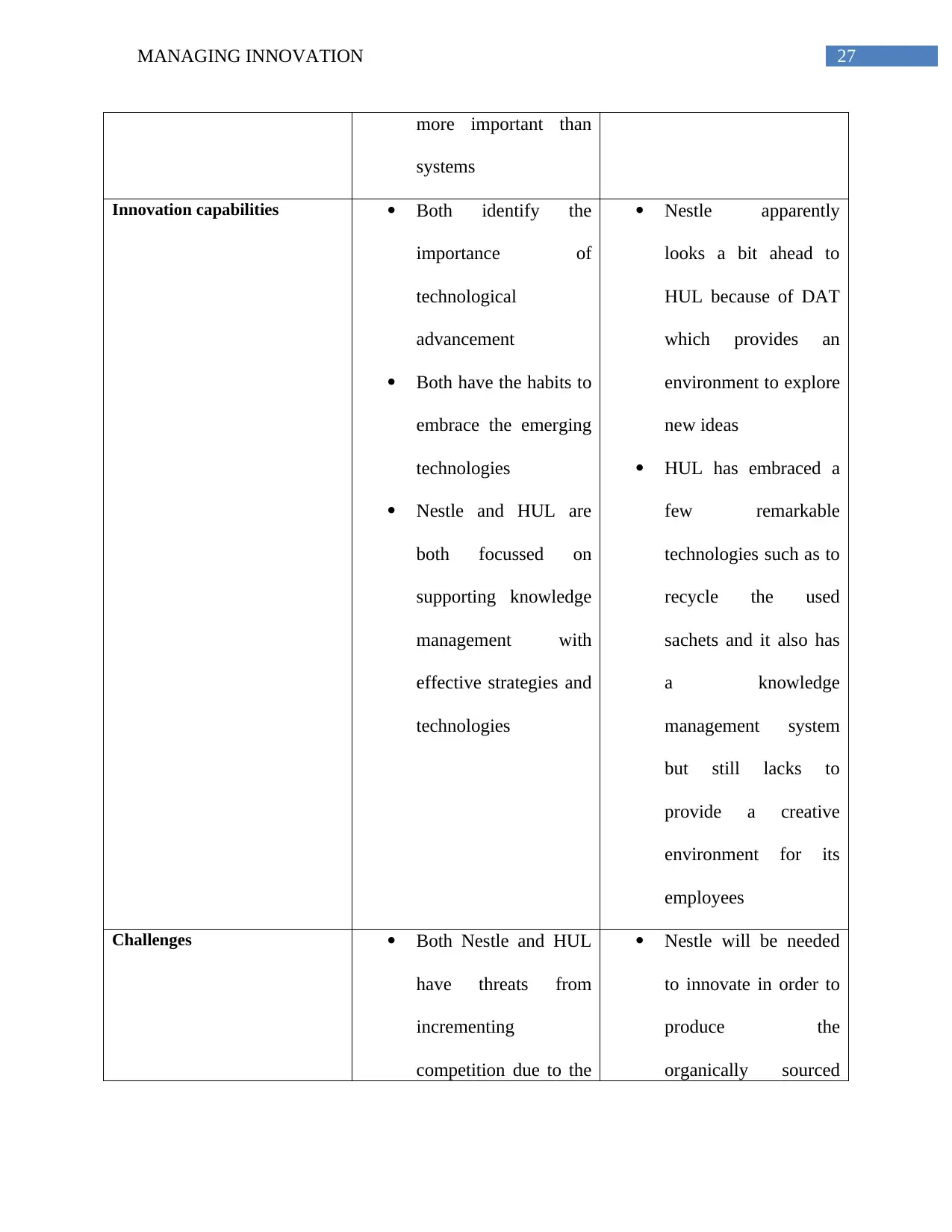
27MANAGING INNOVATION
more important than
systems
Innovation capabilities Both identify the
importance of
technological
advancement
Both have the habits to
embrace the emerging
technologies
Nestle and HUL are
both focussed on
supporting knowledge
management with
effective strategies and
technologies
Nestle apparently
looks a bit ahead to
HUL because of DAT
which provides an
environment to explore
new ideas
HUL has embraced a
few remarkable
technologies such as to
recycle the used
sachets and it also has
a knowledge
management system
but still lacks to
provide a creative
environment for its
employees
Challenges Both Nestle and HUL
have threats from
incrementing
competition due to the
Nestle will be needed
to innovate in order to
produce the
organically sourced
more important than
systems
Innovation capabilities Both identify the
importance of
technological
advancement
Both have the habits to
embrace the emerging
technologies
Nestle and HUL are
both focussed on
supporting knowledge
management with
effective strategies and
technologies
Nestle apparently
looks a bit ahead to
HUL because of DAT
which provides an
environment to explore
new ideas
HUL has embraced a
few remarkable
technologies such as to
recycle the used
sachets and it also has
a knowledge
management system
but still lacks to
provide a creative
environment for its
employees
Challenges Both Nestle and HUL
have threats from
incrementing
competition due to the
Nestle will be needed
to innovate in order to
produce the
organically sourced
Secure Best Marks with AI Grader
Need help grading? Try our AI Grader for instant feedback on your assignments.
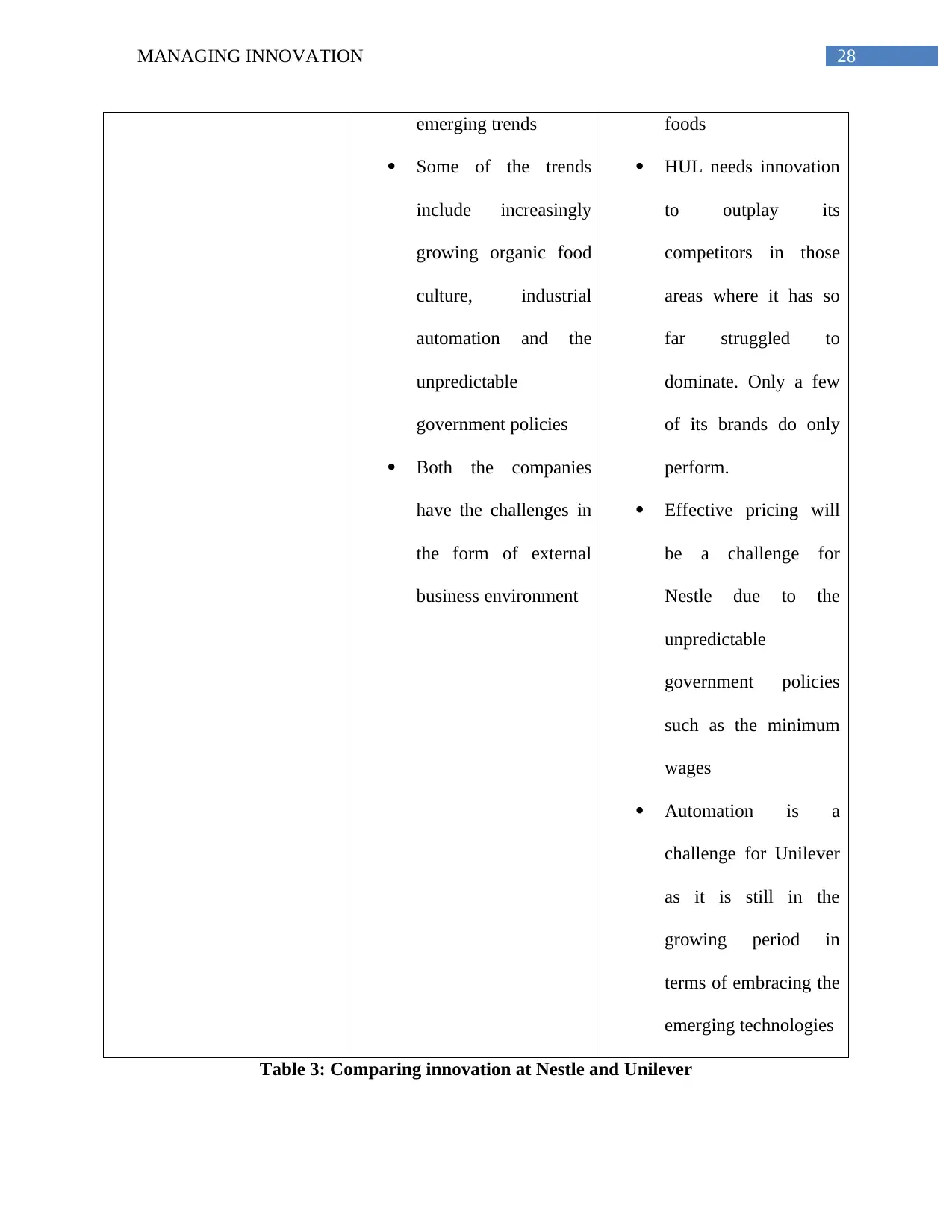
28MANAGING INNOVATION
emerging trends
Some of the trends
include increasingly
growing organic food
culture, industrial
automation and the
unpredictable
government policies
Both the companies
have the challenges in
the form of external
business environment
foods
HUL needs innovation
to outplay its
competitors in those
areas where it has so
far struggled to
dominate. Only a few
of its brands do only
perform.
Effective pricing will
be a challenge for
Nestle due to the
unpredictable
government policies
such as the minimum
wages
Automation is a
challenge for Unilever
as it is still in the
growing period in
terms of embracing the
emerging technologies
Table 3: Comparing innovation at Nestle and Unilever
emerging trends
Some of the trends
include increasingly
growing organic food
culture, industrial
automation and the
unpredictable
government policies
Both the companies
have the challenges in
the form of external
business environment
foods
HUL needs innovation
to outplay its
competitors in those
areas where it has so
far struggled to
dominate. Only a few
of its brands do only
perform.
Effective pricing will
be a challenge for
Nestle due to the
unpredictable
government policies
such as the minimum
wages
Automation is a
challenge for Unilever
as it is still in the
growing period in
terms of embracing the
emerging technologies
Table 3: Comparing innovation at Nestle and Unilever
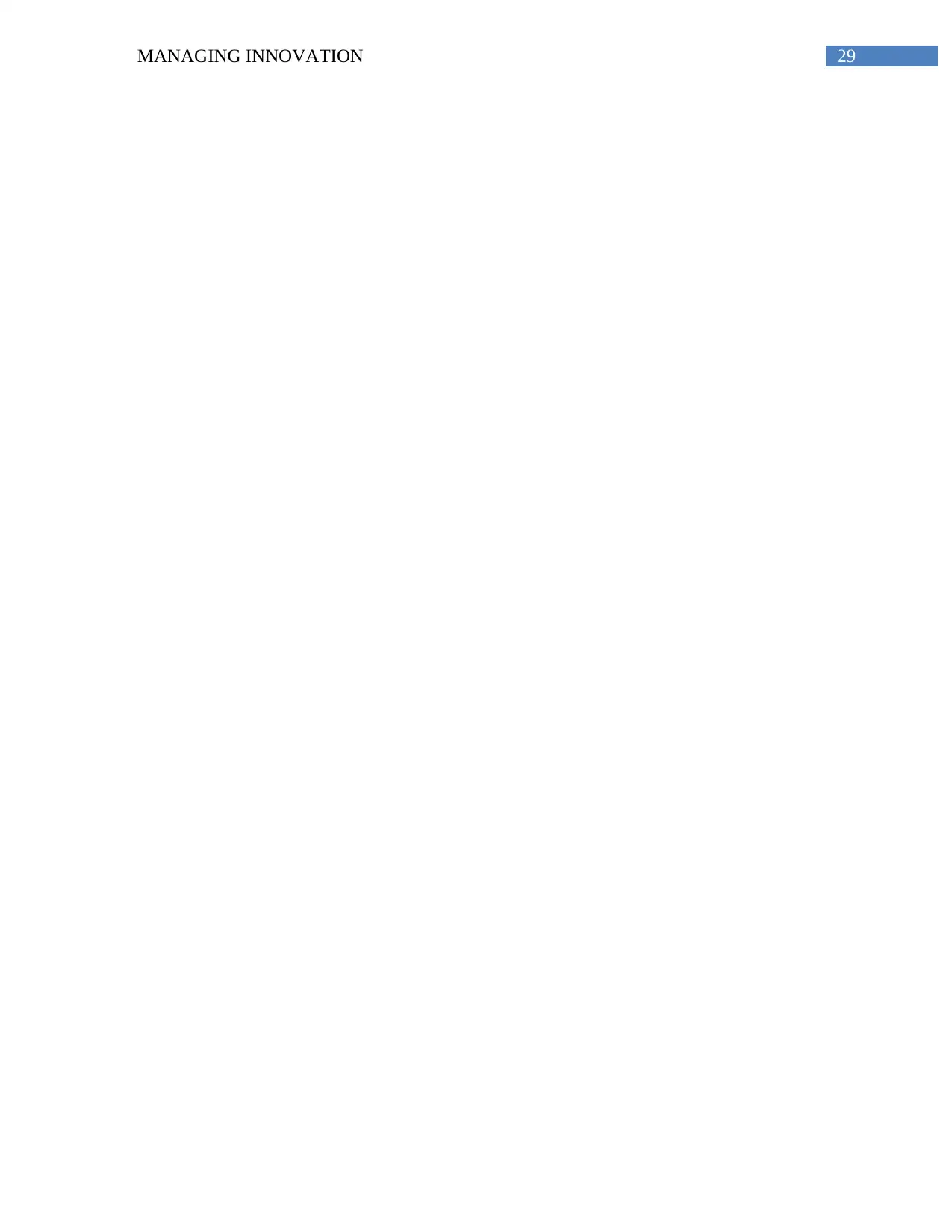
29MANAGING INNOVATION
1 out of 30
Your All-in-One AI-Powered Toolkit for Academic Success.
+13062052269
info@desklib.com
Available 24*7 on WhatsApp / Email
![[object Object]](/_next/static/media/star-bottom.7253800d.svg)
Unlock your academic potential
© 2024 | Zucol Services PVT LTD | All rights reserved.
